Updated May 26th: According to the USPS, there will be ceremonies for the stamps at 14 of the 16 Parks, all but one on the first-day. This list is alphabetical:
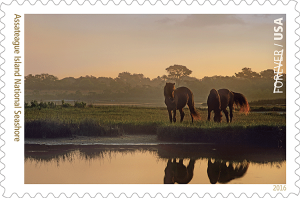 Assateague Island National Seashore
Assateague Island National Seashore
June 2, 11 a.m.
Assateague Island National Seashore
11800 Marsh View Ln.
Berlin MD 21811
Bandelier National Monument
June 2, 11 a.m.
Bandelier National Monument
15 Entrance Rd.
Los Alamos, NM 87544
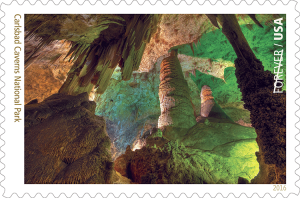 Carlsbad Caverns National Park
Carlsbad Caverns National Park
June 2, 4 p.m.
Carlsbad Caverns National Park
727 Caverns Hwy.
Carlsbad NM 88220
Everglades National Park
June 2, 11 a.m.
Ernest Coe Visitor Center
40001 State Rd 9336
Homestead, FL 33034
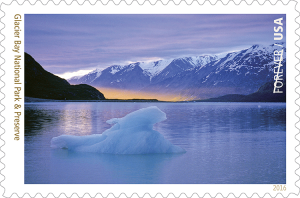 Glacier Bay National Park and Preserve
Glacier Bay National Park and Preserve
June 2, 11 a.m.
1250 Gustavus Rd.
Gustavus, AK 99226-9998
Grand Canyon National Park
June 2 11 a.m.
100 Mather Business Center
Grand Canyon AZ 86023
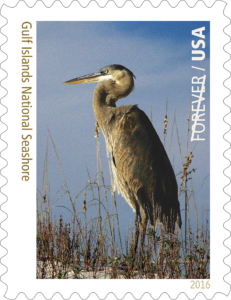 Gulf Islands National Seashore
Gulf Islands National Seashore
June 2, 10 a.m.
[uncertain]
Haleakalā National Park
June 2, 11 a.m.
Makawao Post Office
1075 Makawao Ave.
Makawao HI 96768
Kenilworth Park and Aquatic Gardens
June 2, 11 a.m.
Kenilworth Park and Aquatic Gardens
1550 Anacostia Ave. NE
Washington, DC 20019
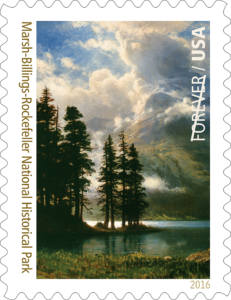 Marsh-Billings-Rockefeller National Historic Park (NHP)
Marsh-Billings-Rockefeller National Historic Park (NHP)
June 4, 10:30 a.m.
The Forest Center at Marsh-Billings-Rockefeller NHP
54 Elm Street
Woodstock, VT 05091
Parking for the event is across the street at the Billings Farm & Museum. There is a short walk from the parking area to the Forest Center. Alternative access is available for those with limited mobility. Please call ahead to make arrangements 802.457.3368 x222.
Mount Rainier National Park
June 2 11 a.m.
Henry M. Jackson Visitor Center,
Mount Rainier National Park
Paradise, WA
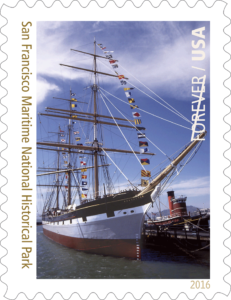 San Francisco Maritime Historical National Park
San Francisco Maritime Historical National Park
June 2, 11 a.m.
San Francisco Maritime National Historical Park
2905 Hyde Street
San Francisco, CA 94109
Theodore Roosevelt National Park
June 2, 11 a.m.
Medora Community Center
465 Pacific Ave.
Medora, ND 58645
Yellowstone National Park
June 2, 9 a.m.
2 Mammoth Hotel Dr.
Yellowstone National Park, WY 82190
Updated April 29th: The first day postmarks: 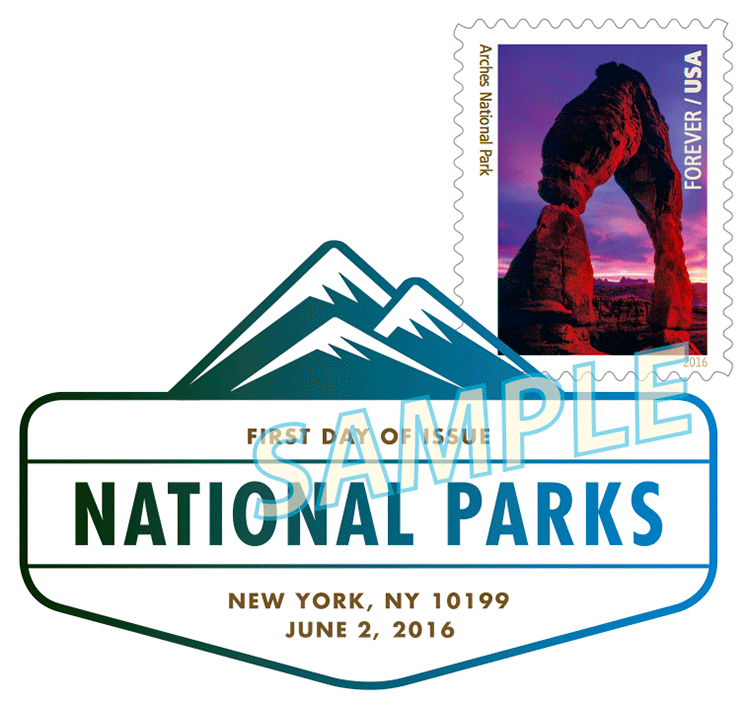 The DCP measures 2.4″ x 1.5″
The DCP measures 2.4″ x 1.5″ 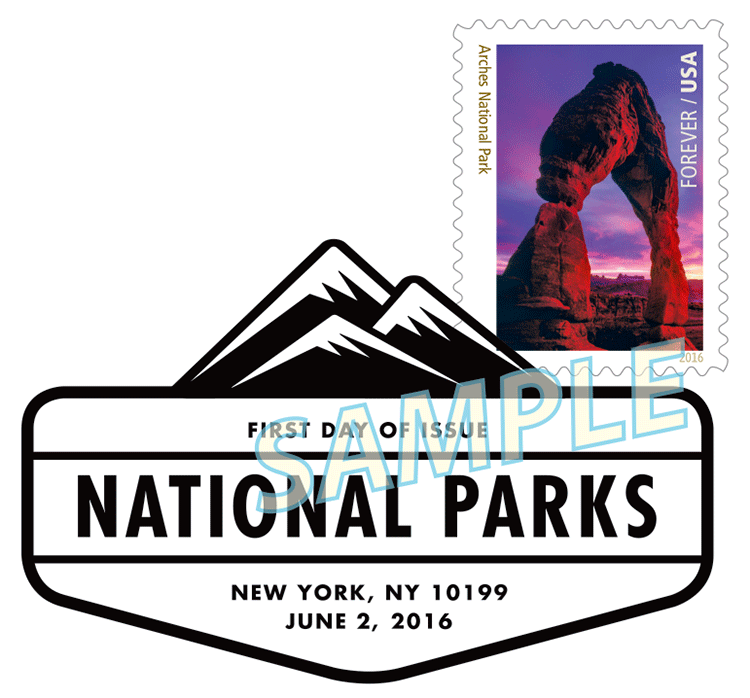 The pictorial first-day postmark measures 2.4″ x 1.5″.
The pictorial first-day postmark measures 2.4″ x 1.5″. 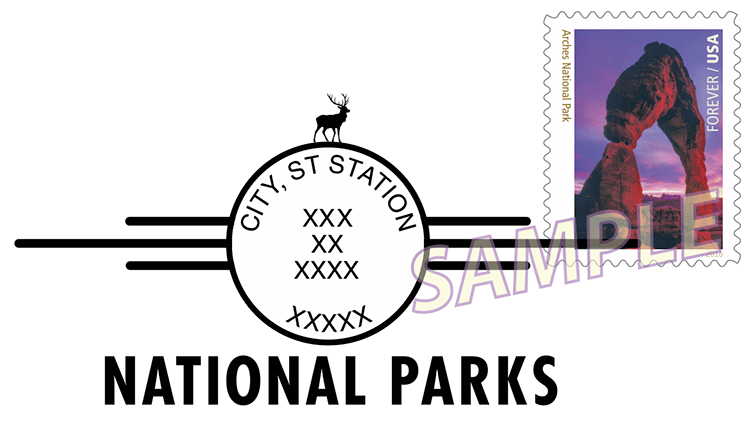 The dedication postmark measures 3.0″ x 1.5″
The dedication postmark measures 3.0″ x 1.5″
Updated April 29th: from the Postal Bulletin
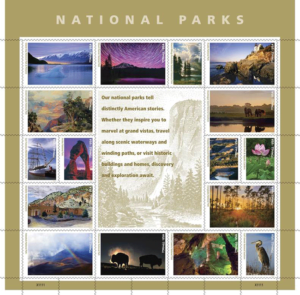 On June 2, 2016, in New York, NY, the U.S. Postal Service® will issue the National Parks stamps (Forever® priced at 47 cents) in 16 designs, in a pressure-sensitive adhesive (PSA) pane of 16 stamps (Item 560600). The National Parks pane of 16 stamps may not be split, and the stamps may not be sold individually.
On June 2, 2016, in New York, NY, the U.S. Postal Service® will issue the National Parks stamps (Forever® priced at 47 cents) in 16 designs, in a pressure-sensitive adhesive (PSA) pane of 16 stamps (Item 560600). The National Parks pane of 16 stamps may not be split, and the stamps may not be sold individually.
The stamps will go on sale nationwide June 2, 2016.
With this pane of stamps, issued in 2016 to coincide with the centennial of the National Park Service, the U.S. Postal Service encourages everyone to visit our national parks and discover — or rediscover — abundant opportunities for exploration, learning, and fun. This pane includes 16 different stamps that feature existing art or photographs of national parks or plants, animals, artwork, objects, and structures found in or associated with a national park. Small type on the margin of each stamp indicates its location.
 First row, left to right: Glacier Bay National Park and Preserve, Alaska (Tom Bean, photographer); Mount Rainier National Park, Washington (Matt Dieterich, photographer); “Scenery in the Grand Tetons” (Albert Bierstadt, artist; painting at Marsh-Billings-Rockefeller National Historical Park, Vermont); Bass Harbor Head Light at Acadia National Park, Maine (David Muench, photographer).
First row, left to right: Glacier Bay National Park and Preserve, Alaska (Tom Bean, photographer); Mount Rainier National Park, Washington (Matt Dieterich, photographer); “Scenery in the Grand Tetons” (Albert Bierstadt, artist; painting at Marsh-Billings-Rockefeller National Historical Park, Vermont); Bass Harbor Head Light at Acadia National Park, Maine (David Muench, photographer).
Second row, left to right: “The Grand Canyon of Arizona, from Hermit Rim Road” (Thomas Moran, artist; chromolithograph-on-canvas at Grand Canyon National Park, Arizona); Assateague Island National Seashore, Virginia and Maryland (Tim Fitzharris, photographer).
Third row, left to right: Balclutha, a ship at San Francisco Maritime National Historical Park, California (Tim Campbell, photographer); Arches National Park, Utah (Tom Till, photographer); Theodore Roosevelt National Park, North Dakota (QT Luong, photographer); Kenilworth Park and Aquatic Gardens, Washington, D.C. (Cindy Dyer, photographer).
Fourth row, left to right: Administration Building at Frijoles Canyon, Bandelier National Monument, New Mexico (Helmuth Naumer, Sr., artist); Everglades National Park, Florida (Paul Marcellini, photographer).
Fifth row, left to right: Haleakalá National Park, Hawaii (Kevin Ebi, photographer); Yellowstone National Park, Idaho, Montana, and Wyoming (Art Wolfe, photographer); Carlsbad Caverns National Park, New Mexico (Richard McGuire, photographer); Gulf Islands National Seashore, Florida and Mississippi (John Funderburk, photographer).
The image at the center of the pane is a detail of the 1-cent Yosemite stamp issued in 1934, rendered here in light brown. The pane includes selvage text and verso text. Art director Ethel Kessler designed the stamps and the stamp pane.
Initial Supply to Post Offices: Item 560600, $7.52, National Parks (Forever priced at 47 cents) Commemorative PSA Pane of 16 Stamps
Stamp Fulfillment Services will make an automatic push distribution to Post Offices™ of a quantity to cover approximately 30 days of sales. Distribution quantities for the automatic push distribution will be available by logging on to SFS Web at https:⁄⁄sfsweb.usps.gov. Post Offices may begin ordering stamps prior to the FDOI through SFS Web. However, offices should check the website noted above to determine the amount they will receive on their automatic push distribution.
There are special dedication postmarks for this issue.
How to Order the First-Day-of-Issue Postmark:
 Customers have 60 days to obtain the first-day-of-issue postmark by mail. They may purchase new stamps at their local Post Office, at The Postal Store® website at http:⁄⁄www.usps.com⁄shop, or by calling 800-782-6724. They should affix the stamps to envelopes of their choice, address the envelopes (to themselves or others), and place them in a larger envelope addressed to:
Customers have 60 days to obtain the first-day-of-issue postmark by mail. They may purchase new stamps at their local Post Office, at The Postal Store® website at http:⁄⁄www.usps.com⁄shop, or by calling 800-782-6724. They should affix the stamps to envelopes of their choice, address the envelopes (to themselves or others), and place them in a larger envelope addressed to:
National Parks Stamps
Special Events Coordinator
380 West 33rd Street
New York, NY 10199-9998
After applying the first-day-of-issue postmark, the Postal Service will return the envelopes through the mail. There is no charge for the postmark up to a quantity of 50. There is a 5-cent charge for each additional postmark over 50. All orders must be postmarked by August 2, 2016.
There are eight philatelic products for this stamp issue:
- 560606, Press Sheet with Die-cut, $67.68 (print quantity 3,000)
- 560610 Keepsake, $9.95
- 560616 First-Day Cover (set of 16), $14.56
- 560618 First-Day Cover, Full Pane, $10.02
- 560619 Cancelled Full Pane, $10.02
- 560621 Digital Color Postmark (set of 16), $25.92
- 560624 Framed Art, $39.95
- 560630 Ceremony Program (random single), $6.95
Technical Specifications:
 Issue: National Parks Stamps
Issue: National Parks Stamps
Item Number: 560600
Denomination & Type of Issue: First-Class Mail Forever
Format: Pane of 16 (16 designs)
Series: N⁄A
Issue Date & City: June 2, 2016
Designer: Ethel Kessler, Bethesda, MD
Art Director: Ethel Kessler, Bethesda, MD
Typographer: Ethel Kessler, Bethesda, MD
Modeler: Sandra Lane⁄Michelle Finn
Manufacturing Process: Offset, Microprint
Printer: Banknote Corporation of America
Printed at: Browns Summit, NC
Press Type: Alprinta 74
Stamps per Pane: 16
Print Quantity: 100 million stamps
Paper Type: Phosphor Tagged Paper, Block
Adhesive Type: Pressure-sensitive
Processed at: Banknote Corporation of America, Browns Summit SC
Colors: Cyan, Magenta, Yellow, Black, PMS 4575 (Gold), PMS 4495 (Gold)
Stamp Orientation: Horizontal and Vertical
Image Area (w x h):
1.68 x 1.05 in.⁄42.67 x 26.67 mm
0.77 x 1.05 in.⁄19.56 x 26.67 mm
Overall Size (w x h):
1.82 x 1.19 in.⁄46.23 x 30.23 mm
0.91 x 1.19 in.⁄23.11 x 30.23 mm
Full Pane Size (w x h): 7.25 x 7.25 in.⁄184.15 x 184.15 mm
Press Sheets Size (w x h): 21.75 x 21.75 in.⁄552.45 x 552.45 mm
Plate Size: 144 stamps per revolution
Plate Numbers: N⁄A Marginal Markings:
Front: Header: National Parks
Back: © 2016 USPS • USPS logo • Barcode (560600) in upper right and lower left corners of pane • Promotional text • Summary of “National Parks”
Updated April 28th: from the USPS:
Postal Service Previews Complete Pane of 16 Stamps
Celebrating National Park Service’s Centennial 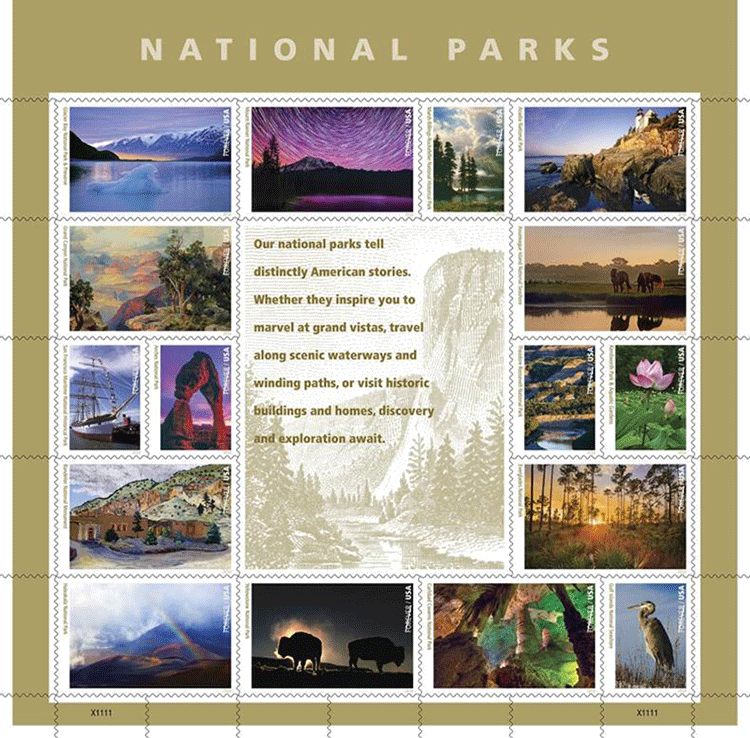 Designer Ethel Kessler arranged the stamps to approximate their locations around America: Alaska’s Glacier Bay National Park and Preserve on the upper left; Maine’s Acadia National Park on the upper right; Hawaii’s Haleakalā National Park on the bottom left; and Florida’s and Mississippi’s Gulf Islands National Seashore on the bottom right.
Designer Ethel Kessler arranged the stamps to approximate their locations around America: Alaska’s Glacier Bay National Park and Preserve on the upper left; Maine’s Acadia National Park on the upper right; Hawaii’s Haleakalā National Park on the bottom left; and Florida’s and Mississippi’s Gulf Islands National Seashore on the bottom right.
Updated April 22nd: from the USPS:
Postal Service Previews Fifteenth of 16 Stamps
Celebrating National Park Service’s Centennial
Stamp Highlights Yellowstone National Park 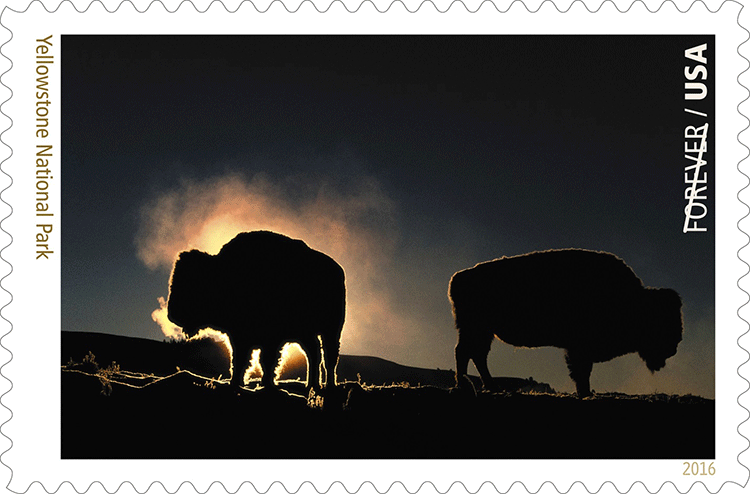 WASHINGTON — A stunning photograph of two bison silhouetted in Yellowstone National Park’s winter morning sun was previewed today as the last of 16 Forever Stamp images to be revealed over a three-week period to celebrate the National Park Service’s 100th anniversary. The uniquely designed stamp pane containing all 16 stamp images will be previewed later this week.
WASHINGTON — A stunning photograph of two bison silhouetted in Yellowstone National Park’s winter morning sun was previewed today as the last of 16 Forever Stamp images to be revealed over a three-week period to celebrate the National Park Service’s 100th anniversary. The uniquely designed stamp pane containing all 16 stamp images will be previewed later this week.
The image was captured by Art Wolfe of Seattle, WA, who described it as, “perfectly backlit bison standing on a small rise in Yellowstone’s Lamar Valley.”
“Rising at dawn and braving the -30°F temperature I was able to catch the first rays of the morning sun,” he explained. “The bitter cold of a long winter’s night had left the animals encased in a mantle of thick frost. I had scouted the area the day before and had seen the herd of bison. They had bedded down there all night and now were standing and trying to shake off the cold as the sun came over the horizon. These are the serendipitous moments I wait for as a photographer. I shot this in the days of film, so I didn’t know until I got back to Seattle and had the film processed if I had been successful or not.”
Wolfe got the February 2000 shot using a Canon EOS-3, EF70-200mm lens set at f/16 for 1/250 sec. using Fujichrome Velvia film.
Yellowstone National Park, ID, MT and WY
Marvel. Explore. Discover. Visit Yellowstone and experience the world’s first national park. Marvel at a volcano’s hidden power rising up in colorful hot springs, mud pots and geysers. Explore mountains, forests and lakes to watch wildlife and witness the drama of the natural world unfold. Discover the history that led to the conservation of our national treasures “for the benefit and enjoyment of the people.” Visit this link for more information.
Updated April 22nd: from the USPS:
Postal Service Previews Fifteenth of 16 Stamps
Celebrating National Park Service’s Centennial
Stamp Highlights Theodore Roosevelt National Park 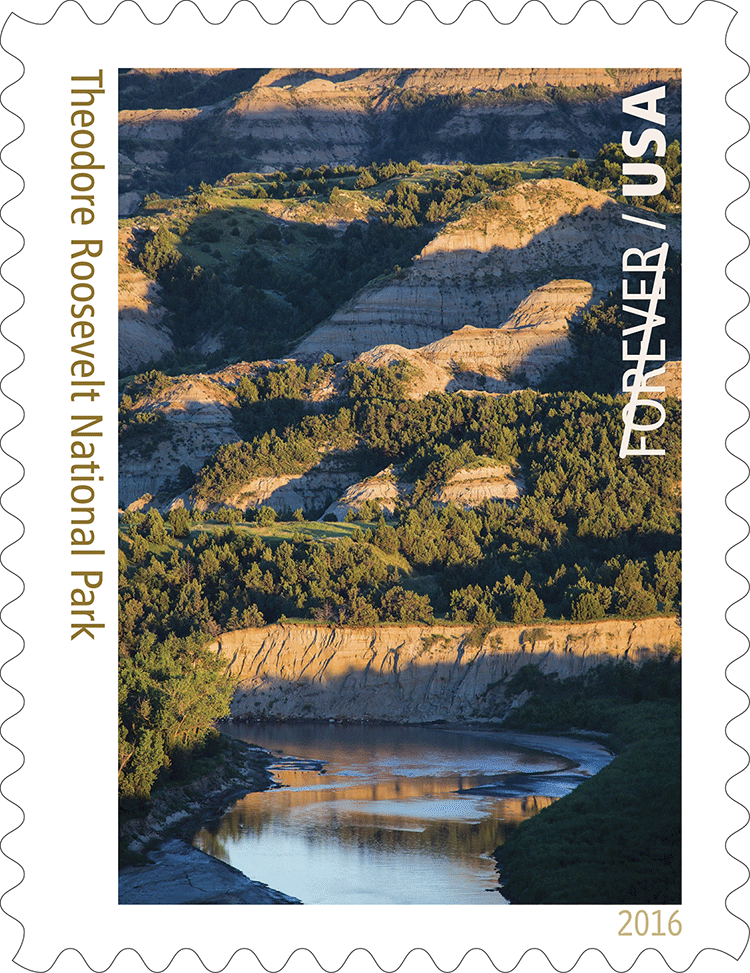 WASHINGTON — A photograph of the Little Missouri River winding through the Badlands of North Dakota’s Theodore Roosevelt National Park was previewed today as the 15th of 16 Forever Stamp images to be revealed over a three-week period to celebrate the National Park Service’s 100th anniversary.
WASHINGTON — A photograph of the Little Missouri River winding through the Badlands of North Dakota’s Theodore Roosevelt National Park was previewed today as the 15th of 16 Forever Stamp images to be revealed over a three-week period to celebrate the National Park Service’s 100th anniversary.
The photograph was taken in July 2013 by Q.T. Luong of San Jose, CA, who captured the image in the North Unit of Theodore Roosevelt National Park in the course of his 20-year project to photograph 59 national parks.
Theodore Roosevelt National Park, ND
According to the National Park Service, when Theodore Roosevelt came to Dakota Territory to hunt bison in 1883, he was a “skinny, young, spectacled New Yorker.” He could not have imagined how his adventure in this remote and unfamiliar place would forever alter the course of the nation. The rugged landscape and strenuous life he experienced here would help shape a conservation policy that we still benefit from today.
Theodore Roosevelt National Park contains several sites of historical significance, each relating to the era of cattle ranching in the late 1800s. Most significant is Theodore Roosevelt’s Elkhorn Ranch Site, the main ranch site where he spent the bulk of his time and where many of his conservation ideas grew. Roosevelt’s first ranch home, the Maltease Cross Cabin, is open for viewing at the South Unit Visitor Center.
The Long X Trail was used as a corridor to move cattle into the Northern Great Plains in the 1800s, and it passes through the North Unit of the park. Peaceful Valley Ranchwas built in the 1880s and served as a dude ranch from 1918 to the 1930s. The ranch and its owners assisted in the establishment of Theodore Roosevelt National Park. Visitors can still ride horses at Peaceful Valley by taking part in a trail ride with the park’s concessionaire. Visit this link for more information.
The Backstory of Luong’s Photograph
Luong was interested in the park’s rugged character and vegetation that set it apart from South Dakota’s Badlands National Park.
“The light of the late afternoon gleaming on the river appeared as a bright ribbon in the landscape,” recounted Luong, who used a telephoto lens to emphasize the section of the river with the reflection.
Luong noted that the park includes three units: the South Unit and the far lesser visited North Unit and Elkhorn Ranch Site.
“The Little Missouri River provides a link between them, reminding me of the fond memories I cherish from the time I spent there.”
Born in Paris, France, Luong trained as a computer scientist. When he came to the United States for what was intended to be a short academic stay, he chose the University of California at Berkeley because of its proximity to Yosemite and his passion for rock-climbing — where he scaled El Capitan several times.
“Upon visiting Yosemite for the first time in 1993, it was love at first sight and it marked the start of my 20-year affair with the national parks. I decided to photograph all of them with a 5 by 7 large format camera, a single-handed, self-financed, monumental project which, as far as I know, had not been completed by anyone before.”
Luong settled in the San Francisco Bay area and started crisscrossing the nation to capture its diverse beauty. By 2002, he had visited 58 national parks. He subsequently left his scientific career to pursue his calling of working as a full-time photographer. In 2009, Ken Burns and Dayton Duncan featured him in the film “The National Parks: America’s Best Idea.”
Also added April 25th:
The picture was taken in July 2013 by Q.T. Luong of San Jose, CA, who captured the image in the North Unit of Theodore Roosevelt National Park in the course of his 20-year project to photograph 59 national parks. In 2009, Ken Burns and Dayton Duncan featured him in the film “The National Parks: America’s Best Idea.”
Check out this three-minute PBS video of his segment on YouTube.
Updated April 21st: from the USPS:
Postal Service Previews Fourteenth of 16 Stamps
Celebrating National Park Service’s Centennial
Stamp Highlights San Francisco Maritime Historical Park 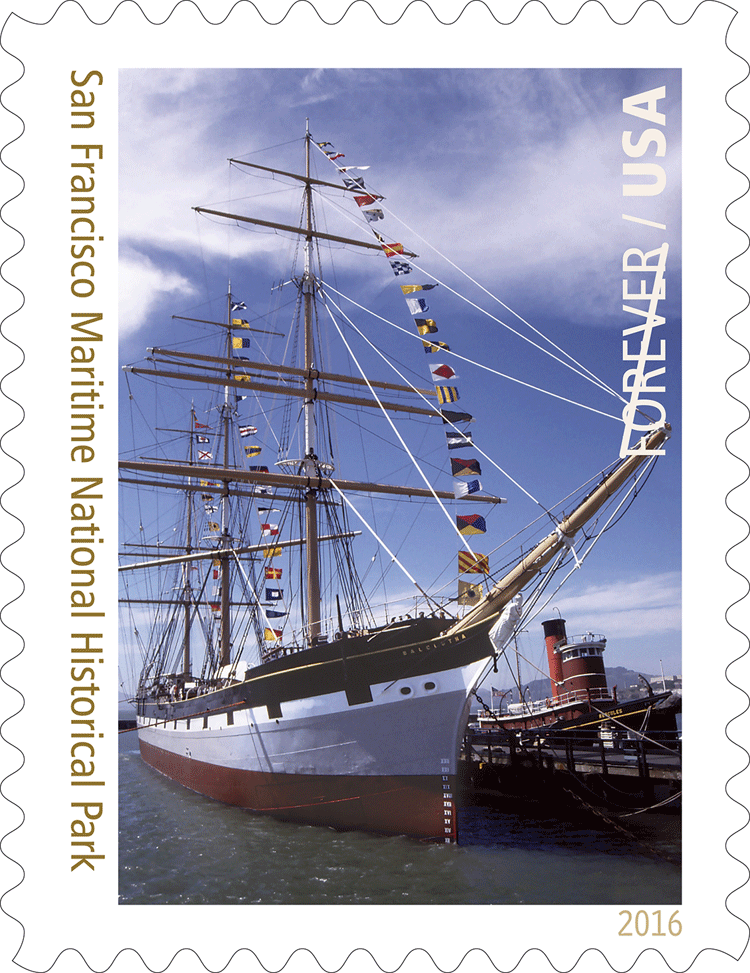 WASHINGTON — A photograph of an iconic three-masted sailing ship was previewed today to highlight San Francisco Maritime Historic National Park as the 14th of 16 Forever Stamp images to be revealed over a three-week period to celebrate the National Park Service’s 100th anniversary.
WASHINGTON — A photograph of an iconic three-masted sailing ship was previewed today to highlight San Francisco Maritime Historic National Park as the 14th of 16 Forever Stamp images to be revealed over a three-week period to celebrate the National Park Service’s 100th anniversary.
San Francisco Maritime National Historic Park, CA
The stamp image* is a portion of a photograph by Tim Campbell of San Francisco, CA, of the square-rigger, Balclutha. Just visible to the right of the deep waterman/salmon packet sailing vessel is the 1907 steam tugboat Hercules.
Located near the Fisherman’s Wharf neighborhood, San Francisco Maritime National Historical Park offers the sights, sounds, smells and stories of Pacific Coast maritime history through five National Historic Landmark vessels berthed here. Visit this link for more information.
Updated April 20th: from the USPS:
Postal Service Previews Thirteenth of 16 Stamps
Celebrating National Park Service’s Centennial
Stamp Depicts Mount Rainier National Park 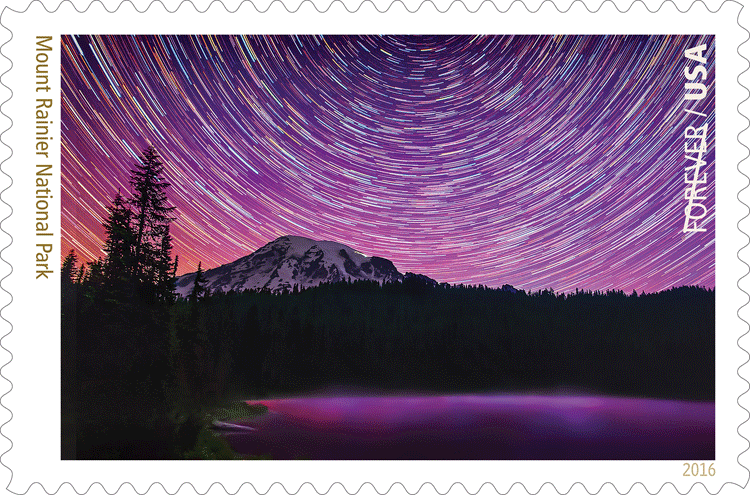
WASHINGTON — A stunning star trail photograph comprised from 200 images was previewed today to celebrate Washington’s Mount Rainier as the 13th of 16 Forever Stamp images to be revealed over a three-week period to celebrate the National Park Service’s 100th anniversary.
Mount Rainier National Park, WA
Ascending to 14,410 feet above sea level, Mount Rainier stands as an icon in the Washington landscape. An active volcano, Mount Rainier is the most glaciated peak in the contiguous United States, spawning six major rivers. Subalpine wildflower meadows ring the icy volcano while ancient forest cloaks Mount Rainier’s lower slopes. Wildlife abounds in the park’s ecosystems. A lifetime of discovery awaits. Visit this link for more information about the park.
Creating the Star Trail Photo
The stamp image is the creation of Matt Dieterich of Pittsburgh, PA. “This night was one I will never forget,” said Dieterich, who worked at Mount Rainier as an intern with the National Park Service Geoscientist-in-the-Parks to educate the public on dramatic views of the stars and the effect of light pollution near highly populated areas. “After working with visitors at the Mount Rainier astronomy program on June 22, 2015, I noticed there was an aurora, so I drove down to Reflection Lake to capture it.”
“The location was perfect as it contained a view of Mount Rainier and water for reflections,” he continued. “To create this star trails image I took 200 photos in a two-hour window between 2 a.m. and 4 a.m. with my Nikon D750 and 24mm lens set at F/1.4 and ISO 5000. Since the Earth is rotating, each 8-sec. exposure shows stars at slightly different locations. When the photos are combined into one image the stars create a circular pattern around the North Star, which is just out of view at the top of the image. The pink aurora spread throughout the background sky. Mountaineers can be seen with their white headlamps climbing Mount Rainier on the right side of the volcano.”
“To capture star trails photos just like this,” he added, “all you need is a digital single lens reflex camera, a wide angle lens, tripod and shutter release cable. So what are you waiting for? Grab your gear and get out under the stars!”
Updated April 19th: from the USPS:
Postal Service Previews Twelfth of 16 Stamps
Celebrating National Park Service’s Centennial
Stamp Depicts a Painting at the Marsh-Billings-Rockefeller National Historical Park that Highlights the Conservation Movement that Led to the First National Parks 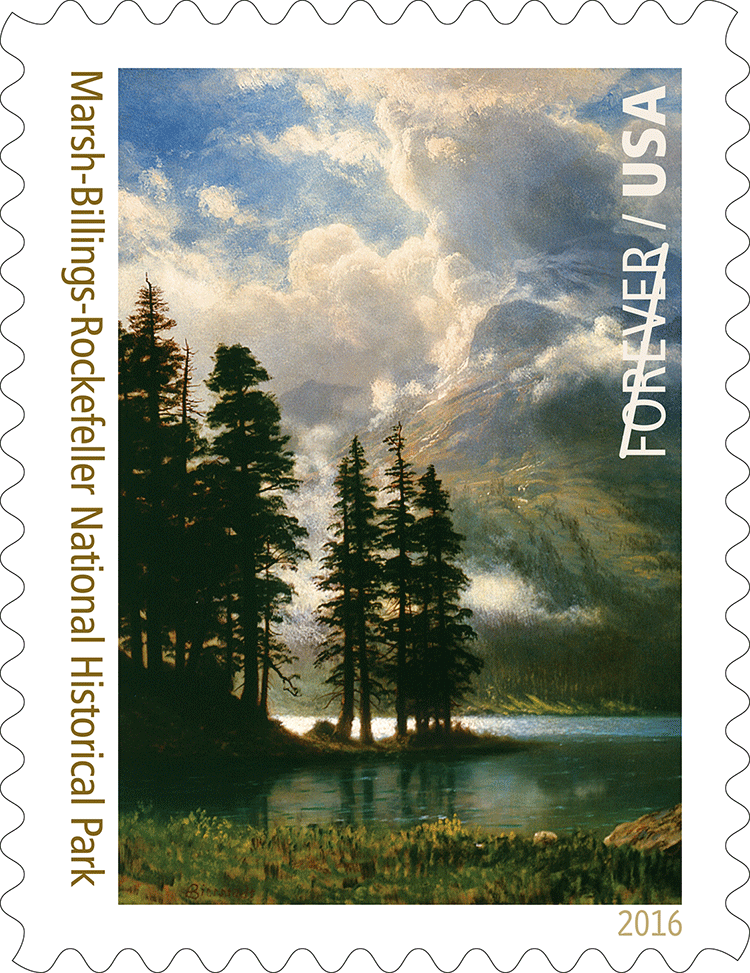 WASHINGTON — An iconic Hudson River School of Art landscape painting linked to the Conservation Movement that supported interest in creating the National Park system was previewed today as the12th of 16 Forever Stamp images to celebrate the National Park Service’s 100th anniversary.
WASHINGTON — An iconic Hudson River School of Art landscape painting linked to the Conservation Movement that supported interest in creating the National Park system was previewed today as the12th of 16 Forever Stamp images to celebrate the National Park Service’s 100th anniversary.
“This stamp exemplifies how our national park treasures extend beyond stunning vistas, wildlife, flora and fauna,” said Stephanie Toothman, Associate Director, Cultural Resources, Partnerships, and Science, National Park Service. “Albert Bierstadt’s painting represents the convergence of artistic, literary and political attention toward America’s scenic beauty in the 19th century, which helped establish conservation as a national value and laid the foundation for the first national parks a century ago.”
The stamp image is a detail of Bierstadt’s (1830–1902) 29-by-43-inch oil-on-canvas painting “Scenery in the Grand Tetons.” The permanent home of the painting is Laurance Rockefeller’s study in the Marsh-Billings-Rockefeller Mansion. The stamp image shows Scenery in the Grand Tetons by Albert Bierstadt, courtesy Marsh-Billings-Rockefeller National Historical Park, MABI 2843
The Conservation Movement and the Marsh-Billings-Rockefeller National Historical Park (NHP)
The fine art collection at Marsh-Billings-Rockefeller National Historical Park is one of the gems of the National Park Service and includes 500 nature and landscape paintings, many by artists associated with the Hudson River School. The collection also includes folk art, modern art, portraits and sculpture.
According to the National Park Service, Rockefeller acquired the painting in the 1960s and added it to the collection of the Marsh-Billings-Rockefeller Mansion as “a reminder of his family’s long loyalty to Grand Teton National Park, and the preservation of the mountains, lake and valley in that spectacularly beautiful and dramatic part of the West.”
The Hudson River School Art Movement
During the 19th century, the artists of a young America searched for a new world view and found it in the very landscapes around them. Inspired by the stunning natural beauty from across the nation, the loose-knit Hudson River School of painters flourished from the mid-1830s to the mid-1870s and gave America its first major school of art.
According to the National Park Service, “Their landscapes sought to recreate the majesty of the natural world and to inspire admiration for its beauty.” Americans who bought their paintings and admired them on the walls of their city homes came to believe that those scenes should be preserved for future generations, not just painted or photographed.
At the same time, the works of authors such as Nathaniel Hawthorne, Henry David Thoreau and Ralph Waldo Emerson also celebrated the beauty and importance of nature.
Marsh-Billings-Rockefeller National Historic Park
The name of the park honors three individuals and their families who played important roles in American conservation history: George Perkins Marsh (1801-1882), Frederick Billings (1823-1890) and Laurance S. Rockefeller (1910-2004).
The lives and contributions of these three generations of stewardship reflect the wide range of attitudes and ideas in the evolution of the conservation movement in the United States. The site was the boyhood home of G. P. Marsh, one of America’s first conservationists, whose 1864 book, Man and Nature, decried the effects of deforestation in Vermont and around the world and provided the intellectual underpinnings of the early conservation movement.
Later, it was the home of Billings, who returned to his native Vermont from California, transformed the property into a progressive farm and country estate, and reforested much of the land around the Mansion. Its most recent owners, Billings’ granddaughter Mary Rockefeller and her husband Laurance Rockefeller, gave the property and its collections to the American people, the latest in a long history of support for National Parks by the Rockefeller family. Rockefeller received the Congressional Gold Medal in 1991 for his contributions to conservation and historic preservation.
Updated April 18th: from the USPS:
Postal Service Previews Eleventh of 16 Stamps
Celebrating National Park Service’s Centennial
Stamp Highlights Kenilworth Park & Aquatic Gardens 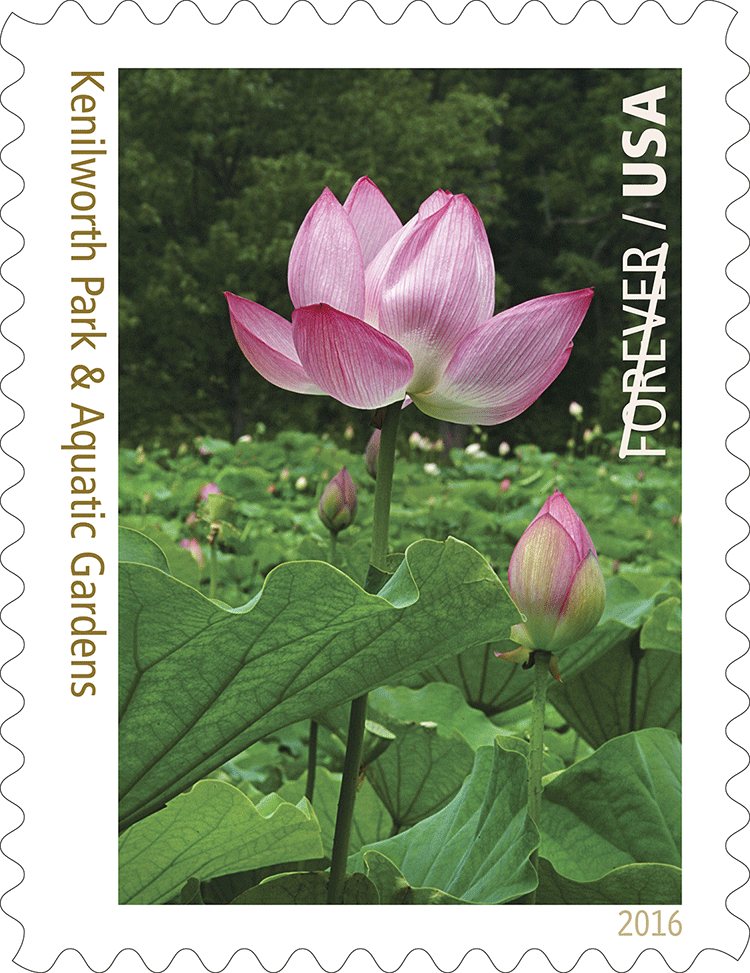 WASHINGTON — A Sacred Lotus with a bloom the size of a basketball in Washington, DC’s Kenilworth Park & Aquatic Gardens is featured on the 11th of 16 Forever Stamp images. The stamps are being revealed individually over a three-week period to celebrate the National Park Service’s 100th anniversary.
WASHINGTON — A Sacred Lotus with a bloom the size of a basketball in Washington, DC’s Kenilworth Park & Aquatic Gardens is featured on the 11th of 16 Forever Stamp images. The stamps are being revealed individually over a three-week period to celebrate the National Park Service’s 100th anniversary.
Kenilworth Park & Aquatic Gardens, DC
The stamp image was photographed by Cindy Dyer of Alexandria, VA, who also provided the images from Kenilworth for the Water Lilies Forever Stamps issued last year. The Sacred Lotus (Nelumbo nucifera), is the star attraction at Kenilworth Park and Aquatic Gardens during its blooming period from late June to early September.
This breathtaking plant is a sample of the hidden treasures tucked away in this time capsule surrounded by urban neighborhoods in our nation’s capital. The original water lilies were planted by a Civil War veteran who bought the 30-acre parcel in the 1880s. The park’s wetlands also provide habitat for many animals including fox, mink and otter. Visit this link for more information.
Updated April 15th: from the USPS:
Postal Service Previews Tenth of 16 Stamps
Celebrating National Park Service’s Centennial
Stamp Highlights Haleakalā National Park 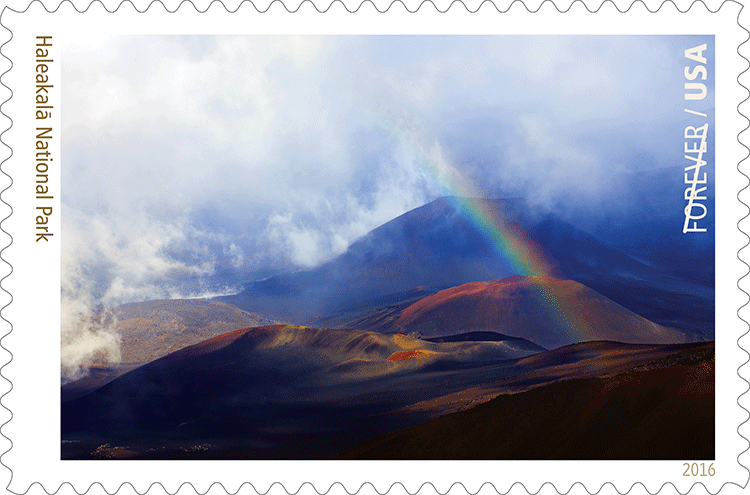 WASHINGTON — A stunning photograph of the late afternoon sun shining into a heavy rain storm, forming rainbows over the crater at Haleakalā National Park, Maui, HI, is the 10th of 16 Forever Stamp images to be revealed over a three-week period to celebrate the National Park Service’s 100th anniversary.
WASHINGTON — A stunning photograph of the late afternoon sun shining into a heavy rain storm, forming rainbows over the crater at Haleakalā National Park, Maui, HI, is the 10th of 16 Forever Stamp images to be revealed over a three-week period to celebrate the National Park Service’s 100th anniversary.
Haleakalā National Park, HI
Haleakalā National Park vibrates with stories of ancient and modern Hawaiian culture and protects the bond between the land and its people. The park also cares for endangered species, some of which exist nowhere else. Come visit this special place — renew your spirit amid stark volcanic landscapes and sub-tropical rain forest with an unforgettable hike through the backcountry. Visit this link for more information.
The Story Behind the Photo
The photograph is the work of Kevin Ebi, who lives near Seattle, WA. Following is his narrative of capturing the image:
“When you think of Hawaii, you probably imagine continuous summer, warm water and hot beaches. But a couple hours after landing on Maui, I was in the freezing cold, pelted by hail, surrounded by thunderclouds. For a few minutes at a time, the sun would briefly break through it, using rainbows as spotlights to illuminate Haleakalā’s volcanic cinder cones.
As a nature photographer, I was in heaven — or at least 10,000 feet closer to it.
Whether it’s because of the explosive growth of photography, or our need to take a break from our always-on, connected lives, our national parks are busier than ever. But for me, they can still be wondrous places of solitude. Such was the case that afternoon I spent chasing Haleakalā’s rainbows.
My day started as a scouting trip. Haleakalā is known for stunning sunrises. Getting that sunrise would require me to arrive at my shooting location while it was still dark. I decided to take a look at the crater during the day in order to determine where I wanted to be the next morning.
But the closer I got to Haleakalā’s summit, the less I could see. The fog got thicker and thicker. Then there was heavy rain. Then the rain turned to hail. I sprinted from the car into the visitor center, hoping to catch a bit of the view through the window. All I could make out was the railing of the viewing platform.
It quickly became clear that the storm wouldn’t stop. The few visitors in the center sprinted to their cars. I decided to stay put.
Then something amazing happened. The hail turned into a light drizzle. Sunlight poked through a tiny hole in the ominous cloud. And a rainbow dipped into the crater.
I managed to get a few shots before the sun slid back behind the storm clouds and the pelting hail resumed. It was a beautiful scene. Much of Haleakalā’s beauty comes from its rainbow-colored rocks. The rainbow in the sky complemented that nicely.
But I hoped for better placement of the rainbow. In those first images it was off to the side of the crater. I knew that as the sun moved across the sky, weather permitting, rainbows later in the day would land closer to a core group of cinder cones that I found especially attractive. And so I waited.
During the hour and a half I spent on the rim, the storm gave me just six opportunities to photograph rainbows. My favorite image — and the one that is used on the stamp — was taken during the next-to-last ‘window.’ It was also the briefest opportunity. I was able to shoot only a single frame before the rainbow vanished.
Back in the car, with the heat and the de-fogger set on high, I was thankful for the experience even though I was soaked. In all of my work as a photographer, I treasure most the images that show nature at its dynamic finest. Braving an intense hailstorm is just part of the experience — a key part of the experience.
National parks take us into a different world, a world of jaw-dropping scenery and experiences that are dramatically different from our daily lives. This image of Haleakalā is both to me. And it’s why I’m so honored that it will help commemorate the 100th anniversary of the National Park Service.”
Updated April 14th: from the USPS:
Postal Service Previews Ninth of 16 Stamps
Celebrating National Park Service’s Centennial
Stamp Highlights Gulf Islands National Seashore 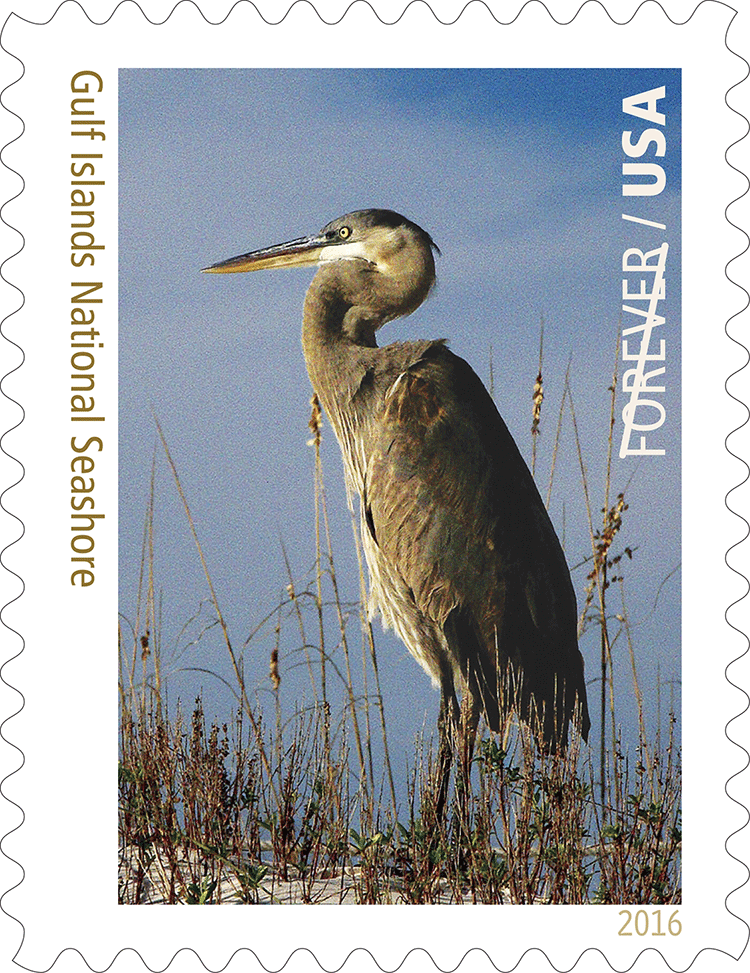 WASHINGTON — A photograph of a long-legged water bird with a wingspan that can exceed six feet was previewed today to highlight Gulf Islands National Seashore as the ninth of 16 Forever Stamp images to be revealed over a three-week period to celebrate the National Park Service’s 100th anniversary.
WASHINGTON — A photograph of a long-legged water bird with a wingspan that can exceed six feet was previewed today to highlight Gulf Islands National Seashore as the ninth of 16 Forever Stamp images to be revealed over a three-week period to celebrate the National Park Service’s 100th anniversary.
Gulf Islands National Seashore, FL and MS
The stamp image is a photograph of a heron by amateur photographer John Funderburk of Hernando, FL. Whether you visit the seashore for a day or a week there are many activities and places to explore. Each of the seashore’s many areas in Florida and Mississippi offer unique experiences. Visit this link for more information.
Updated April 13th: from the USPS:
Postal Service Previews Eighth of 16 Stamps
Celebrating National Park Service’s Centennial
Stamp Highlights Grand Canyon National Park 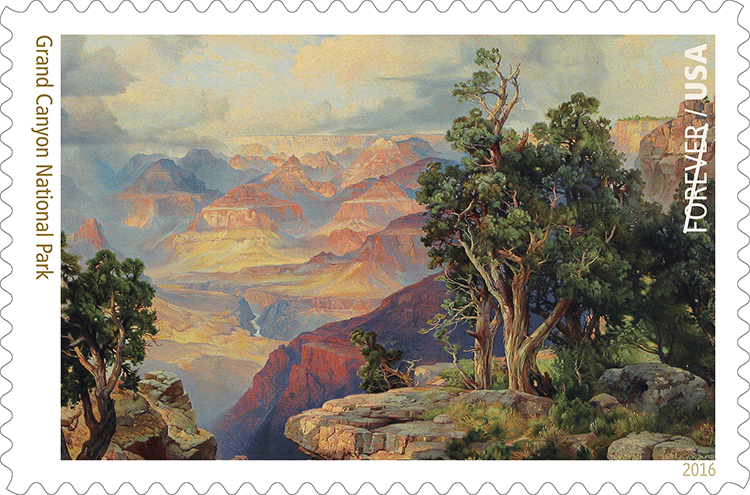 WASHINGTON — An iconic painting of one of the seven natural wonders of the world — the Grand Canyon — was previewed today as the eighth of 16 Forever Stamp images to be revealed over a three-week period to celebrate the National Park Service’s 100th anniversary.
WASHINGTON — An iconic painting of one of the seven natural wonders of the world — the Grand Canyon — was previewed today as the eighth of 16 Forever Stamp images to be revealed over a three-week period to celebrate the National Park Service’s 100th anniversary.
Grand Canyon National Park, AZ
The stamp image is a detail of a chromolithograph-on-canvas, “The Grand Canyon of Arizona, from Hermit Rim Road,” by artist Thomas Moran (1837–1926). Unique combinations of geologic color and erosional forms decorate a canyon that is 277 river miles long, up to 18 miles wide and one mile deep. Grand Canyon overwhelms our senses through its immense size. Visit this link for more information about the park.
Updated April 12th: from the USPS:
Postal Service Previews Seventh of 16 Stamps
Celebrating National Park Service’s Centennial
Stamp Highlights Glacier Bay National Park and Preserve 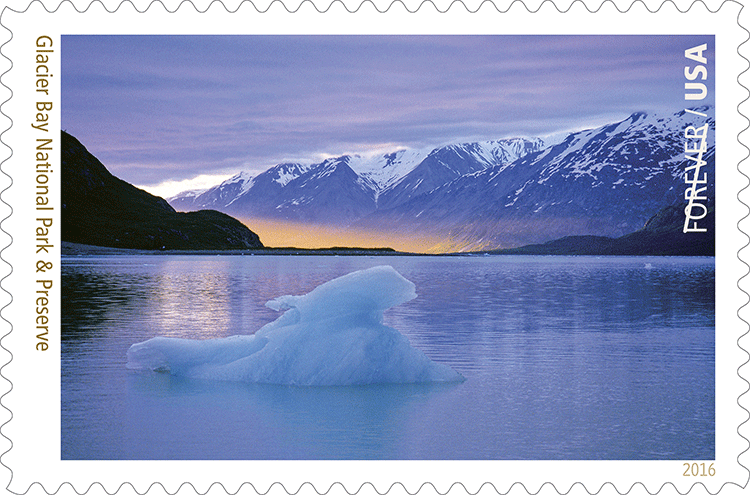 WASHINGTON — A stunning photograph of Glacier Bay was previewed today as the seventh of 16 Forever Stamp images to be revealed over a three-week period to celebrate the National Park Service’s 100th anniversary.
WASHINGTON — A stunning photograph of Glacier Bay was previewed today as the seventh of 16 Forever Stamp images to be revealed over a three-week period to celebrate the National Park Service’s 100th anniversary.
Glacier Bay National Park and Preserve, AK
The stamp image is a photograph by Tom Bean of Flagstaff, AZ. Covering 3.3 million acres of rugged mountains, dynamic glaciers, temperate forests, wild coastlines and deep sheltered fjords, Glacier Bay National Park and Preserve is a highlight of Alaska’s Inside Passage and part of a 25-million acre World Heritage Site — one of the world’s largest international protected areas. From sea to summit, Glacier Bay National Park and Preserve offers limitless opportunities for adventure and inspiration. Visit this link for more information.
The photograph is by Tom Bean of Flagstaff, AZ. He writes, courtesy of the USPS:
Notes on Photographing Glacier Bay National Park, by Tom Bean
“My personal history with photography is very closely tied to the National Park Service.
I graduated from Iowa State University in 1971 with a degree in Fisheries and Wildlife Management, but I had no real interest or experience with photography. I didn’t even own a camera.
My first job out of college was with the National Park Service, working five summers as a seasonal ranger-naturalist at Wind Cave National Park in the Black Hills of South Dakota. While there, I developed an interest in photographing its magnificent wildlife and varied landscapes of prairie and forest, to illustrate my evening campfire programs—the slide shows and lectures about the park that I presented in an outdoor amphitheater. My boss, Chief Naturalist Jack O’Brien, encouraged me. He even let me borrow some of the park’s equipment so that I could shoot photos for the park’s slide files, to be used by the rest of the staff. I bought my first camera in 1972.
By 1976, I was offered my first job as a professional photographer. Jack O’Brien hired me to shoot photos for the slide files at Grand Canyon National Park, where he was then Chief Naturalist. That same year, I was offered a summer ranger job at Glacier Bay National Park in Alaska. I think one reason I was offered this job was my experience taking photos for Wind Cave and Grand Canyon national parks.
I spent five summers at Glacier Bay National Park, and one at Denali National Park. At Glacier Bay, I spent most of my days off out in the park, photographing the majestic beauty of its mountains, glaciers, rainforest, mist, and fog.
In 1982, I decided to see if it could be possible to make a living as a professional nature photographer. I moved to Flagstaff, Arizona, largely because it is near to so many of America’s great national parks.
I returned to Glacier Bay National Park in 1987, this time to photograph for the National Geographic Society. My assignment was to shoot the Inside Passage, from Vancouver in Canada all the way up to Glacier Bay. The photo used on the Glacier Bay National Park stamp was taken while I was on a kayak trip there in July, 1987. We were camped at Reid Inlet, where a beautiful sunset reflected in the still waters as this iceberg floated slowly past our campsite.
This photo did not make it into the final edit of the book project I was working on for National Geographic, but it has always been one of my favorite images from that assignment. I’m so pleased it has been selected for this postage stamp that commemorates the 100th Anniversary of the National Park Service. I’ve been fortunate to be able to visit a great many of our national park areas in my career and recording the special qualities that make each park unique has been my inspiration every time a visit a park and a central theme of my life as a photographer.”
Updated April 11th: from the USPS:
Postal Service Previews Sixth of 16 Stamps
Celebrating National Park Service’s Centennial
Stamp Highlights Everglades National Park 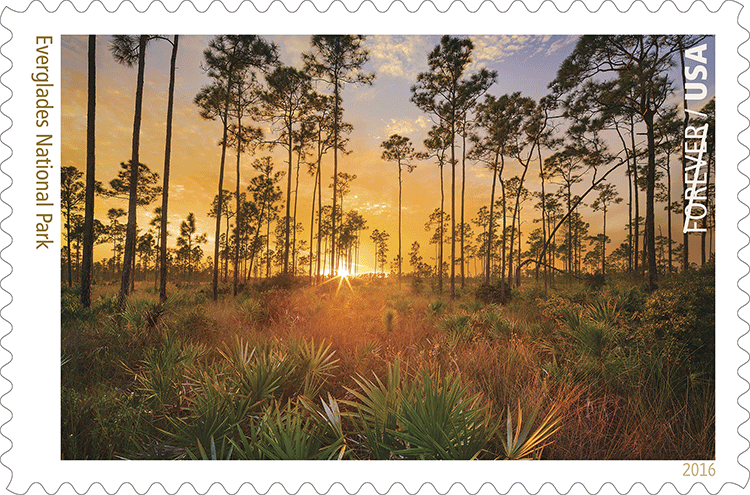 WASHINGTON — A setting sun photograph of pinelands and grasses in the United States’ largest subtropical wilderness — Everglades National Park — was previewed today as the sixth of 16 Forever Stamp images to be revealed over a three-week period to celebrate the National Park Service’s 100th anniversary.
WASHINGTON — A setting sun photograph of pinelands and grasses in the United States’ largest subtropical wilderness — Everglades National Park — was previewed today as the sixth of 16 Forever Stamp images to be revealed over a three-week period to celebrate the National Park Service’s 100th anniversary.
Everglades National Park, FL
The stamp image is a photograph by Paul Marcellini of Miami, FL. Spanning the south Florida peninsula from Miami to Naples and south to the Florida Keys, Everglades National Park’s 1.5 million acres of sawgrass prairies, tropical hardwood hammocks, pine rocklands, mangrove forests and marine and estuarine waters provide habitat for a wildlife spectacle like no other. Crocodiles, alligators, manatees, flamingos, herons and turtles are just a small sampling of wildlife that can be seen here. Visit this link for more information about the park.
Updated April 8th: from the USPS:
Postal Service Previews Fifth of 16 Stamps
Celebrating National Park Service’s Centennial
Stamp Highlights New Mexico’s Carlsbad Caverns National Park 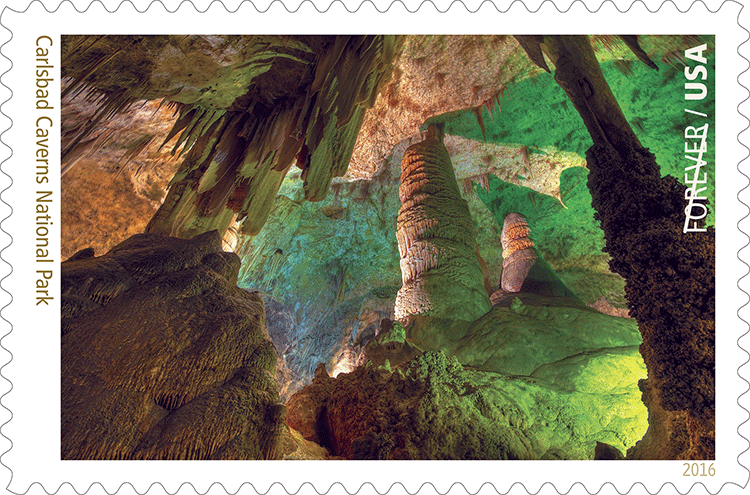 WASHINGTON — A dramatic photograph of the interior of Carlsbad Caverns was previewed today as the fifth of 16 Forever Stamp images to be revealed over a three-week period to celebrate the National Park Service’s 100th anniversary.
WASHINGTON — A dramatic photograph of the interior of Carlsbad Caverns was previewed today as the fifth of 16 Forever Stamp images to be revealed over a three-week period to celebrate the National Park Service’s 100th anniversary.
Carlsbad Caverns National Park, NM
The stamp image is a photograph by Richard McGuire of the interior of the caverns. High ancient sea ledges, deep rocky canyons, flowering cacti and desert wildlife are all treasures above and below the Chihuahuan Desert ground. Carlsbad Cavern is one of more than 300 limestone caves in a fossil reef laid down by an inland sea 240 million to 280 million years ago. Visit this link for more information.
Other National Park Forever Stamps previewed to date include Acadia National Park and Arches National Park, Assateague Island National Seashore and Bandelier National Monument.
Updated April 7th: from the USPS:
Postal Service Previews Fourth of 16 Stamps
Celebrating National Park Service’s Centennial
Stamp Highlights New Mexico’s Bandelier National Monument 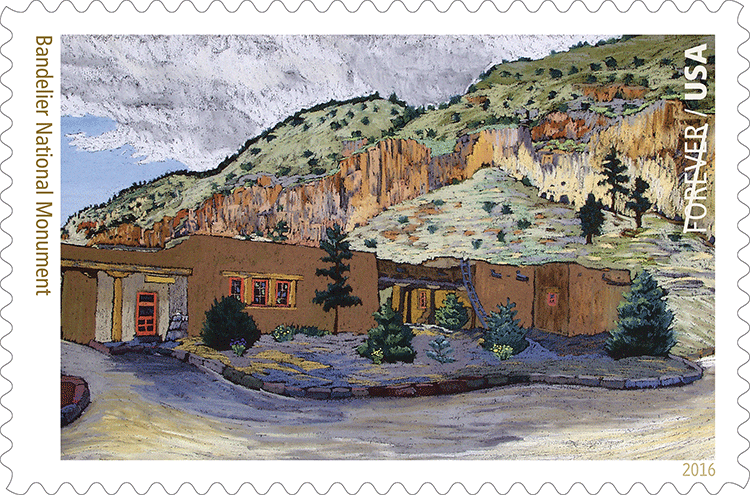 WASHINGTON — A 1930s painting by renowned artist Helmuth Naumer depicting the Pueblo Revival-style visitor center at Bandelier National Monument near Los Alamos, NM, was previewed today as the fourth of 16 Forever stamp images to be revealed over a three week period to celebrate the National Park Service’s 100th anniversary.
WASHINGTON — A 1930s painting by renowned artist Helmuth Naumer depicting the Pueblo Revival-style visitor center at Bandelier National Monument near Los Alamos, NM, was previewed today as the fourth of 16 Forever stamp images to be revealed over a three week period to celebrate the National Park Service’s 100th anniversary.
Bandelier National Monument, NM
The stamp image is a 1935–1936 pastel-on-paper depiction by Helmuth Naumer, Sr. (1907–1990) of the visitor center in Frijoles Canyon. Bandelier National Monument protects over 33,000 acres of rugged, beautiful canyon and mesa country as well as evidence of a human presence here going back more than 11,000 years. Petroglyphs, dwellings carved into the soft rock cliffs, and standing masonry walls pay tribute to the early days of a culture that still survives in the surrounding communities. Visit this link for information on this national treasure.
Administration Building, Frijoles Canyon
Helmuth Naumer, Sr.
Bandelier National Monument, BAND 1409
Updated April 6th: from the USPS:
Postal Service Previews Third of 16 Stamps
Celebrating National Park Service’s Centennial
Stamp Highlights Assateague Island National Seashore 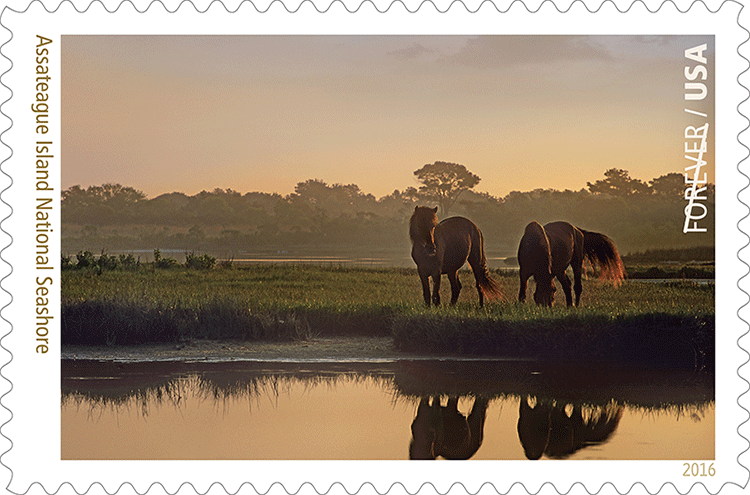 WASHINGTON — Wild horses of Maryland’s and Virginia’s Assateague Island National Seashore were previewed today as the third of 16 Forever Stamp images to be revealed over a three-week period to celebrate the National Park Service’s 100th anniversary. A photograph by Tim Fitzharris of Fayetteville, AR, was used to create the image.
WASHINGTON — Wild horses of Maryland’s and Virginia’s Assateague Island National Seashore were previewed today as the third of 16 Forever Stamp images to be revealed over a three-week period to celebrate the National Park Service’s 100th anniversary. A photograph by Tim Fitzharris of Fayetteville, AR, was used to create the image.
Assateague Island National Seashore, MD and VA
This barrier island is a tale of constant movement and change. Explore sandy beaches, salt marshes, maritime forests and coastal bays. Bands of wild horses freely roam amongst plants and native animals that have adapted to a life of sand, salt and wind. Visit this linkfor more information about Assateague Island National Seashore. Other National Park Forever Stamps previewed to date include Acadia National Park and Arches National Park.
Updated April 5th: from the USPS:
Postal Service Previews Second of 16 Stamps
Celebrating National Park Service’s Centennial
Stamp Highlights Utah’s Arches National Park
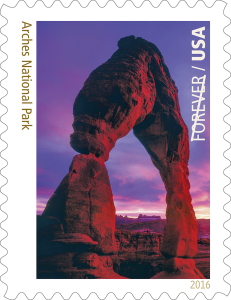 WASHINGTON — Today, the U.S. Postal Service previewed the second in its series of 16 Forever stamps commemorating the centennial of the National Park Service. The 16 stamps, intended to represent the diversity of areas in our national park system, are being previewed over the next three weeks.
WASHINGTON — Today, the U.S. Postal Service previewed the second in its series of 16 Forever stamps commemorating the centennial of the National Park Service. The 16 stamps, intended to represent the diversity of areas in our national park system, are being previewed over the next three weeks.
Arches National Park, Moab, UT
The stamp image is a photograph by Tom Till of Moab, UT, and represents the iconic Delicate Arch. Delicate Arch is just one of more than 2,000 stone arches in a park that contains the greatest density of natural arches in the world. The park is a landscape of contrasting colors, landforms and textures with thousands of natural stone arches, hundreds of soaring pinnacles, massive fins and giant balanced rocks. Visit this link for more information about Arches National Park and this link to download the Arches Visitor Guide.
The Postal Service previewed the Acadia National Park Forever stamp yesterday.
The June 2 first-day-of-issue ceremony for the National Parks Forever stamps pane will take place at New York City’s Javits Center at 11 a.m. as part of World Stamp Show-NY 2016. Dedication ceremonies also will take place at or near each of the National Parks depicted on the stamps. Individuals are encouraged to spread the news on social media by using the hashtags #FindYourPark or #NPS100.
Updated April 4th: from the USPS:
Postal Service Previews First of 16 Stamps
Celebrating National Park Service’s Centennial
Stamp Depicts Acadia National Park’s Bass Harbor Head Light  WASHINGTON — A stamp image featuring a stunning photograph of Acadia National Park’s Bass Harbor Head Light was previewed today as the first of 16 Forever stamp images to be revealed over a three week period to celebrate the National Park Service’s 100th anniversary.
WASHINGTON — A stamp image featuring a stunning photograph of Acadia National Park’s Bass Harbor Head Light was previewed today as the first of 16 Forever stamp images to be revealed over a three week period to celebrate the National Park Service’s 100th anniversary.
The June 2 first-day-of-issue ceremony for the National Parks Forever stamps pane will take place at New York City’s Javits Center at 11 a.m. as part of World Stamp Show-NY 2016. Dedication ceremonies also will take place at or near each of the National Parks depicted on the stamps. Individuals are asked to spread the news on social media by using the hashtags #FindYourPark or #NPS100.
Acadia National Park, Bar Harbor, ME
The stamp image depicting the Bass Harbor Head Light was photographed by David Muench. People have been drawn to the rugged coast of Maine throughout history. Awed by its beauty and diversity, early 20th-century visionaries donated the land that became Acadia National Park. The park is home to many plants and animals, and the tallest mountain on the U.S. Atlantic coast. Today visitors come to Acadia to hike granite peaks, bike historic carriage roads, or relax and enjoy the scenery. For more information on Acadia, visit this link.
World Stamp Show-NY 2016 will take place May 28 – June 4. Held only once a decade this mega event is not to be missed by beginners through advanced stamp collectors alike. There will be something for everyone there, no matter what you collect. Stamp collecting is a hobby for a lifetime. No matter what your specialty, you’ll find it at the show.
Updated March 30th: The first-day is June 2nd. The designs will be previewed one at a time “to build excitement.”
Press release:
National Park Service’s 100th Anniversary
to be Celebrated on Forever Stamps
16 Parks to be Previewed
WASHINGTON — The U.S. Postal Service will begin celebrating the National Park Service’s Aug. 25 centennial just in time for summer vacation letter writing by issuing a pane of stunning Forever stamps depicting 16 examples of our national treasures on June 2.
To create buzz and excitement among national park fans, each stamp will be previewed alphabetically over the next three weeks, beginning Monday, April 4.
“These stamps celebrate the 100th anniversary of the National Parks and depict the beauty and diversity of these national treasures,” said Postmaster General Megan J. Brennan. “They serve as an inspiration for Americans to visit, learn and to write cherished memories of their trips to these incredible wonders.”
“This set of stamps will take people on a journey to some of the most amazing places in the world,” said National Park Service Director Jonathan B. Jarvis. “We are thrilled that the 16 national park stamps issued in ’16 for the centennial depict the variety of parks that collectively tell the story of our country.”
The June 2 first-day-of-issue ceremony will take place at New York City’s Javits Center at 11 a.m. as part of World Stamp Show NY-2016. Dedication ceremonies also will take place at or near each of the national parks depicted on the stamps. Individuals are asked to spread the news on social media by using the hashtags #FindYourPark or #NPS100.
World Stamp Show NY-2016 will take place May 28-June 4. Held only once a decade, this mega event is not to be missed by beginners through advanced stamp collectors alike. There will be something for everyone there, no matter what you collect. Stamp collecting is a hobby for a lifetime. No matter what your specialty, you’ll find it at the show.
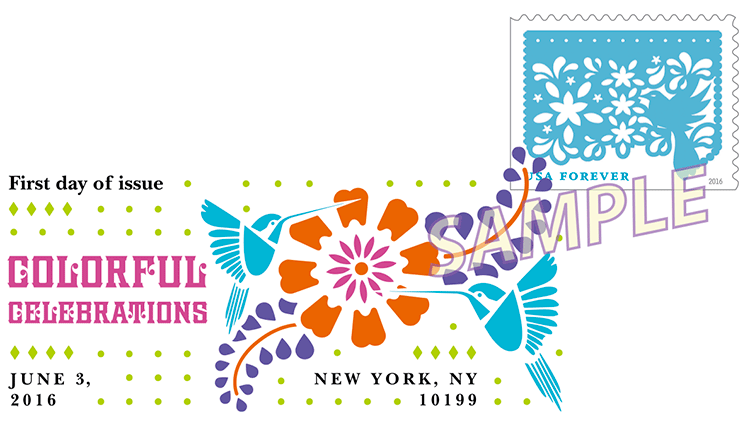 The DCP measures 2.93” x 1.40”
The DCP measures 2.93” x 1.40” 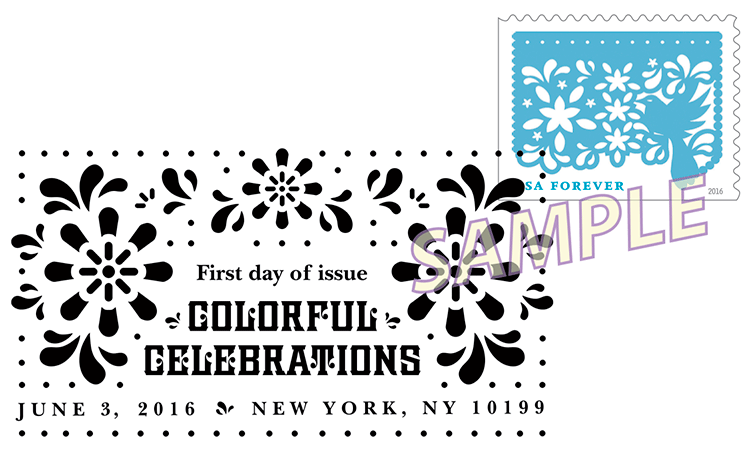 The pictorial measures 2.70” x 1.43”
The pictorial measures 2.70” x 1.43”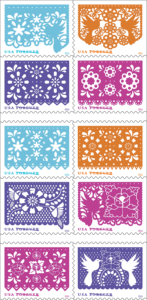 On June 3, 2016, in New York, NY, the U.S. Postal Service® will issue the Colorful Celebrations stamps (Forever® priced at 47 cents) in 10 designs, in a pressure-sensitive adhesive (PSA) double-sided booklet of 20 stamps (Item 681000).
On June 3, 2016, in New York, NY, the U.S. Postal Service® will issue the Colorful Celebrations stamps (Forever® priced at 47 cents) in 10 designs, in a pressure-sensitive adhesive (PSA) double-sided booklet of 20 stamps (Item 681000).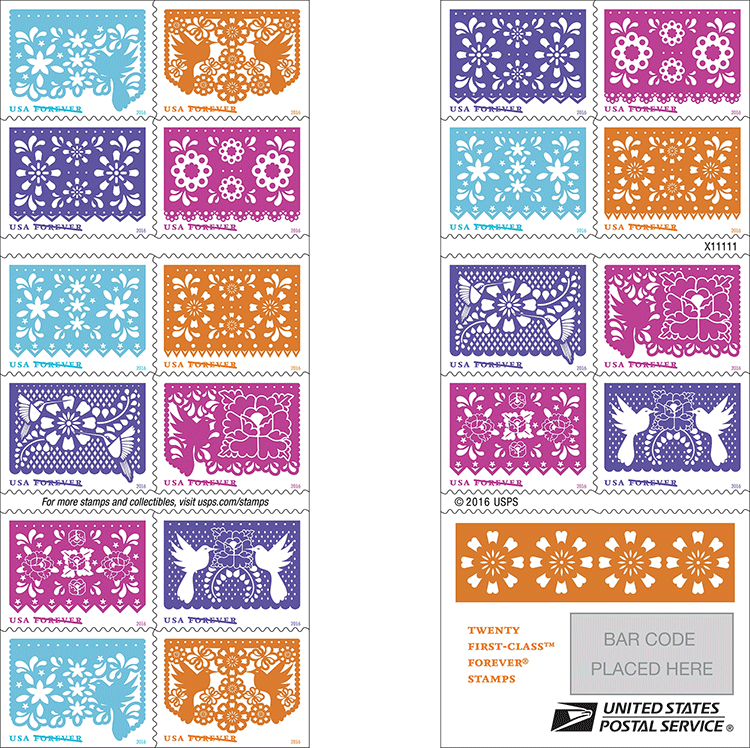 [Configuration of the booklet pane above]
[Configuration of the booklet pane above]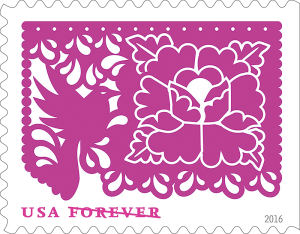 them in a larger envelope addressed to:
them in a larger envelope addressed to: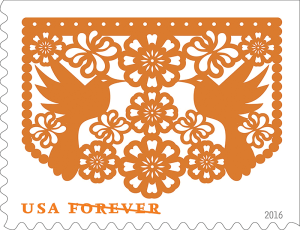 Issue: Colorful Celebrations Stamp
Issue: Colorful Celebrations Stamp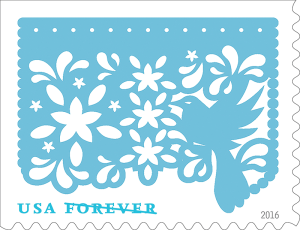 Updated April 1, 2016: From the USPS: We want to clarify that these are illustrations inspired by the traditional art of Papel Picado. They are not cut paper themselves and they do not strictly follow the thematic traditions of the Mexican art form.
Updated April 1, 2016: From the USPS: We want to clarify that these are illustrations inspired by the traditional art of Papel Picado. They are not cut paper themselves and they do not strictly follow the thematic traditions of the Mexican art form.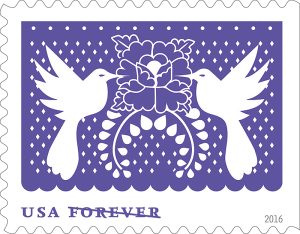 “pierced paper.” Crafted with sharp tools and layers of tissue paper, papel picado designs often include birds, flowers, and religious iconography. The elaborate decorations are hung during holidays, weddings, birthdays, and other festivities.
“pierced paper.” Crafted with sharp tools and layers of tissue paper, papel picado designs often include birds, flowers, and religious iconography. The elaborate decorations are hung during holidays, weddings, birthdays, and other festivities.
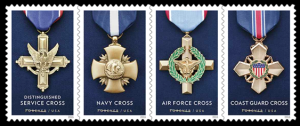 The USPS’ full name for this issue: “Honoring Extraordinary Heroism: The Service Cross Medals.”
The USPS’ full name for this issue: “Honoring Extraordinary Heroism: The Service Cross Medals.”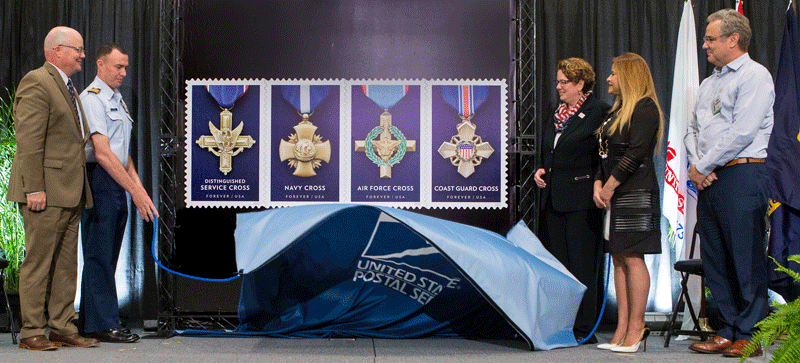 Left to right: David E. Williams, Chief Operating Officer and Executive Vice President, USPS; Captain Thomas Morkan, Deputy Commander, Sector New York, U.S. Coast Guard; Kristin Seaver, Chief Information Officer and Executive Vice President, USPS; Lilliam Rodriguez, Postmaster, Bronx, NY; Greg Breeding, USPS Art Director for this issue.
Left to right: David E. Williams, Chief Operating Officer and Executive Vice President, USPS; Captain Thomas Morkan, Deputy Commander, Sector New York, U.S. Coast Guard; Kristin Seaver, Chief Information Officer and Executive Vice President, USPS; Lilliam Rodriguez, Postmaster, Bronx, NY; Greg Breeding, USPS Art Director for this issue. “Story after story, act after act reveals a new profile in courage and a spirit of American greatness that has defined this nation from the very beginning,” said Seaver (photo right). “These medals — and these stamps — pay homage to such heroic actions and dedication to duty.”
“Story after story, act after act reveals a new profile in courage and a spirit of American greatness that has defined this nation from the very beginning,” said Seaver (photo right). “These medals — and these stamps — pay homage to such heroic actions and dedication to duty.”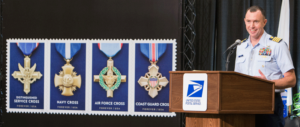 willingness to lay your life on the line for your country is what we as a nation pause to reflect upon and to pay homage to on Memorial Day. It is a great day for parades and celebrations and backyard barbeques with family and friends — but it is also the day that we honor those who since the war of independence have done what needed to be done.
willingness to lay your life on the line for your country is what we as a nation pause to reflect upon and to pay homage to on Memorial Day. It is a great day for parades and celebrations and backyard barbeques with family and friends — but it is also the day that we honor those who since the war of independence have done what needed to be done.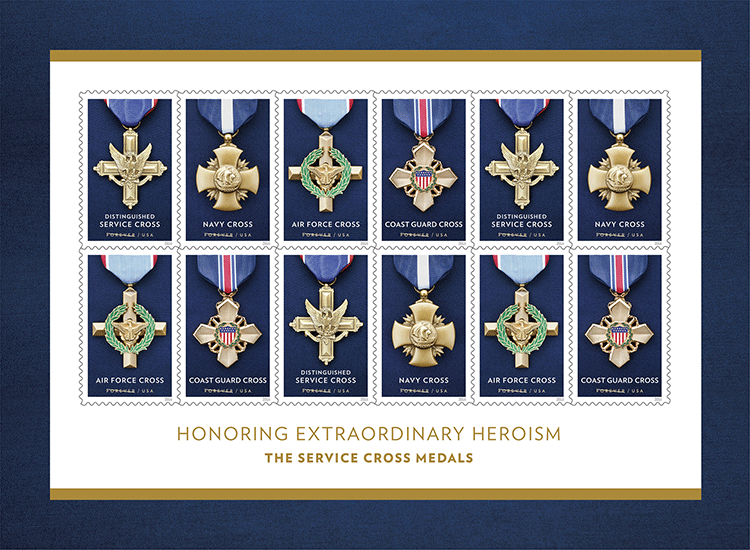
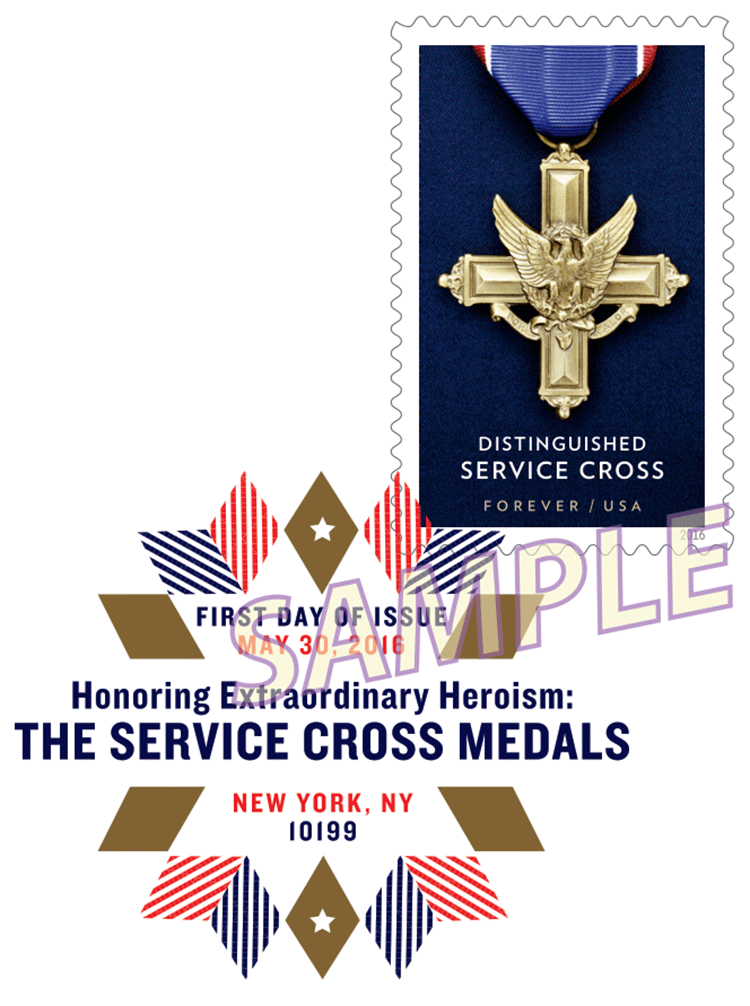 The DCP measure 1.81” x 1.50”
The DCP measure 1.81” x 1.50” 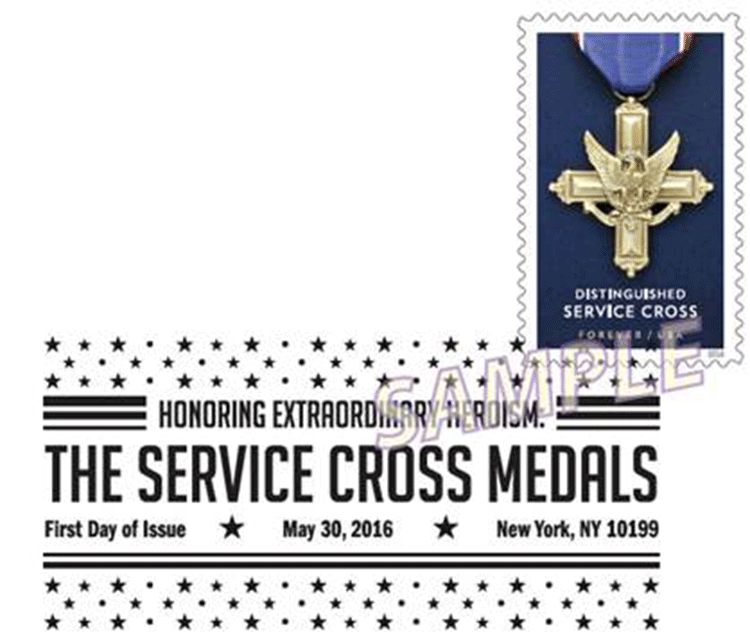 The pictorial postmark measures 2.76 x 1.32”
The pictorial postmark measures 2.76 x 1.32” 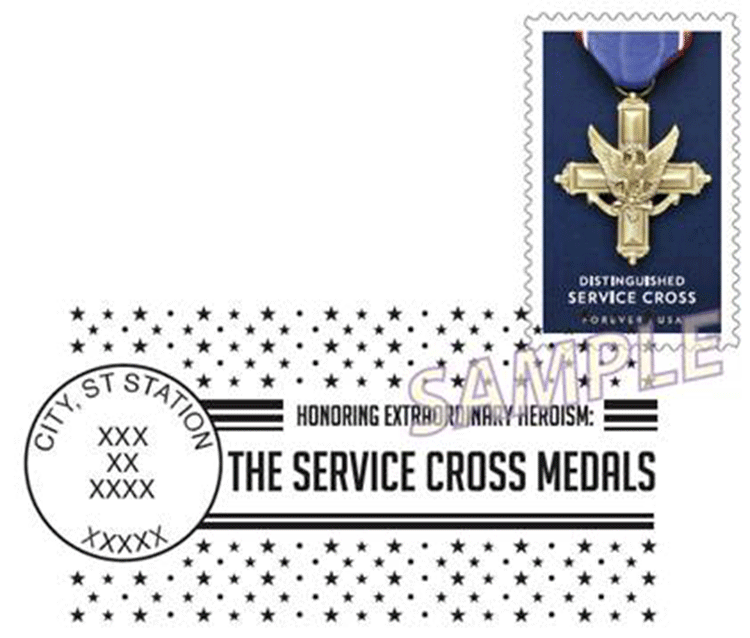 The special dedication postmarks measure 2.98” x 1.48”
The special dedication postmarks measure 2.98” x 1.48”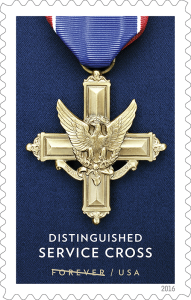 From the USPS, March 31, 2016:
From the USPS, March 31, 2016: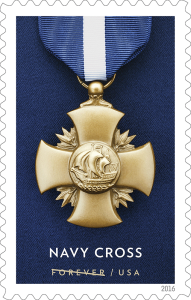 While engaged in an action against an enemy of the United States;
While engaged in an action against an enemy of the United States;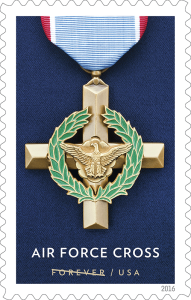 operating under the Department of the Navy or during military operations against international terrorists. This decoration is yet to be awarded.
operating under the Department of the Navy or during military operations against international terrorists. This decoration is yet to be awarded.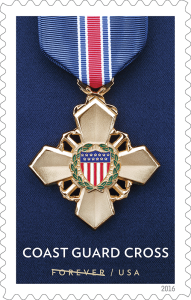
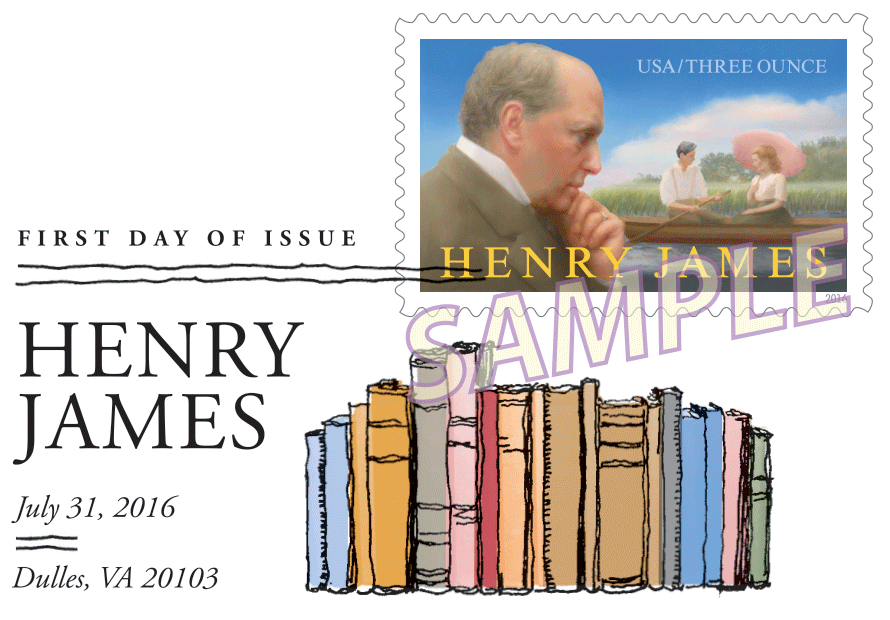
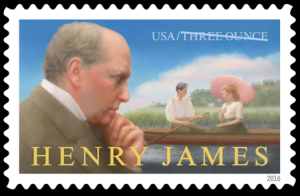 On July 31, 2016, in Dulles, VA, the U.S. Postal Service will issue the Henry James three ounce rate mail use stamp (Non-denominated priced at 89 cents) in one design, in a pressure-sensitive adhesive (PSA) pane of 20 stamps (Item 119400).
On July 31, 2016, in Dulles, VA, the U.S. Postal Service will issue the Henry James three ounce rate mail use stamp (Non-denominated priced at 89 cents) in one design, in a pressure-sensitive adhesive (PSA) pane of 20 stamps (Item 119400).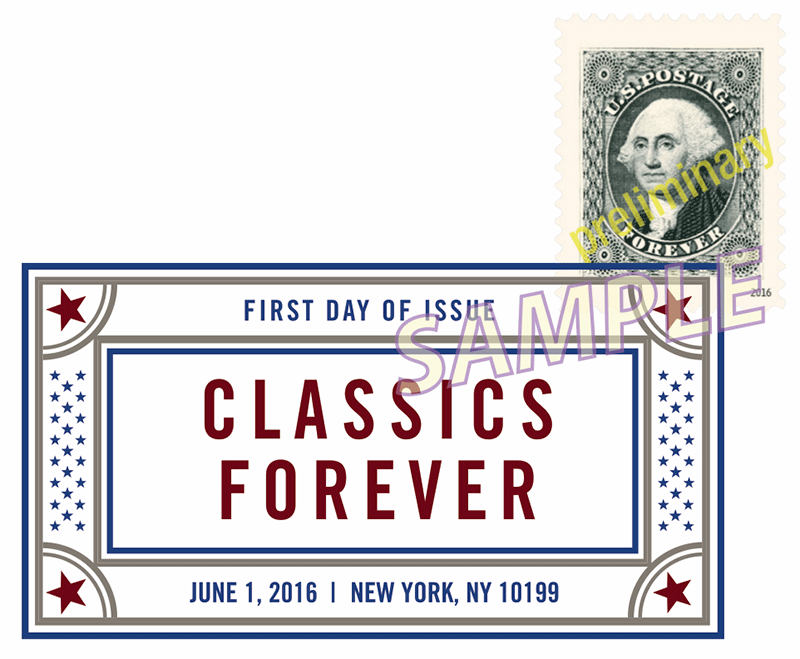
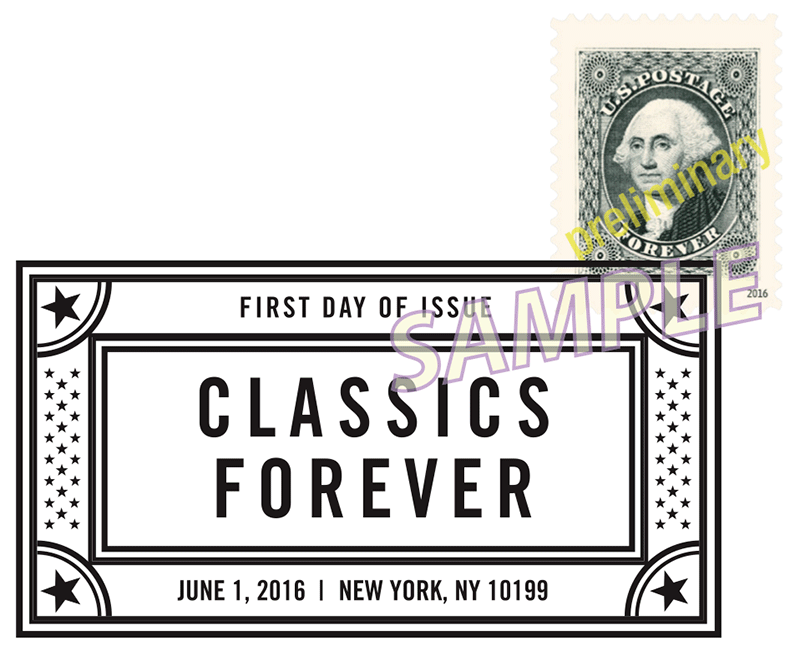 Both postmarks measure 2.81” x 1.50″.
Both postmarks measure 2.81” x 1.50″.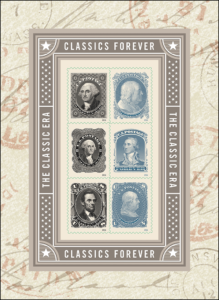 In the article “Stamp Announcement 16-18: Classics Forever Stamps, in Postal Bulletin 22440 (4-28-16, page 51), the following information has been updated:
In the article “Stamp Announcement 16-18: Classics Forever Stamps, in Postal Bulletin 22440 (4-28-16, page 51), the following information has been updated: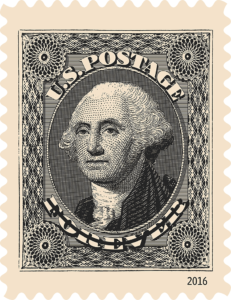 Item Number: 586800
Item Number: 586800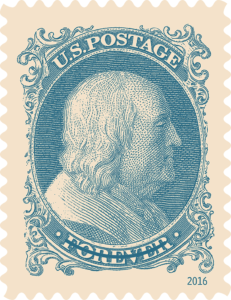 Press Type: Alprinta 74
Press Type: Alprinta 74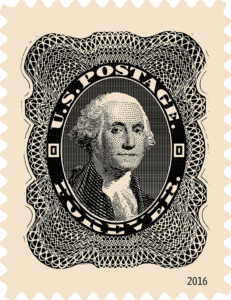 Full Pane Size (w x h): 4.75 x 6.5 in.⁄120.65 x 165.10 mm
Full Pane Size (w x h): 4.75 x 6.5 in.⁄120.65 x 165.10 mm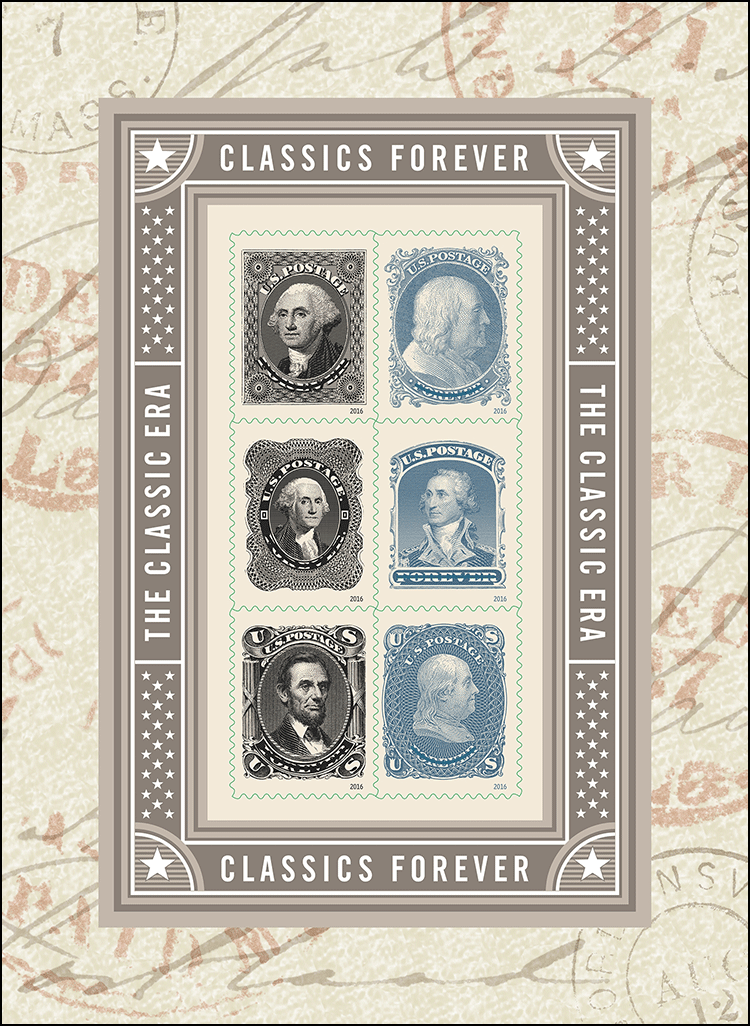
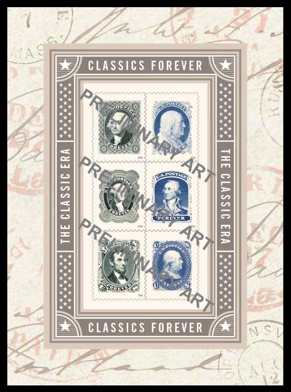 From the USPS, March 31, 2016:
From the USPS, March 31, 2016: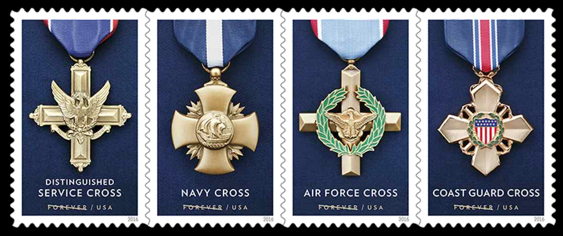
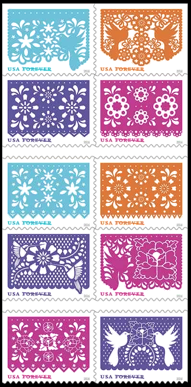 Henry James, Literary Arts, 3-ounce rate.
Henry James, Literary Arts, 3-ounce rate. 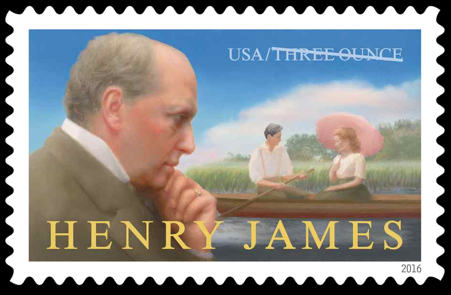 All but James will be issued at World Stamp Show-NY 2016
All but James will be issued at World Stamp Show-NY 2016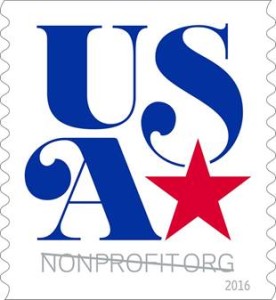 On April 28, 2016, in Dulles, VA, the U.S. Postal Service® will issue the USA nondenominated, nonprofit organization stamp (5-cent value), in one design, in a pressure-sensitive adhesive (PSA) coil of 10,000 (Item 777500).
On April 28, 2016, in Dulles, VA, the U.S. Postal Service® will issue the USA nondenominated, nonprofit organization stamp (5-cent value), in one design, in a pressure-sensitive adhesive (PSA) coil of 10,000 (Item 777500). On April 28, 2016, in Dulles, VA, the U.S. Postal Service will issue the USA nondenominated, nonprofit organization stamp (5-cent value), in one design in a pressure-sensitive adhesive (PSA) coil of 10,000 (Item 777500).
On April 28, 2016, in Dulles, VA, the U.S. Postal Service will issue the USA nondenominated, nonprofit organization stamp (5-cent value), in one design in a pressure-sensitive adhesive (PSA) coil of 10,000 (Item 777500).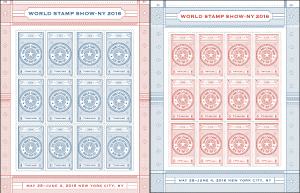 A February 28th press release from the U.S. international stamp show says, “Four of the seven USPS first day of issue releases scheduled to take place are depicted” in the
A February 28th press release from the U.S. international stamp show says, “Four of the seven USPS first day of issue releases scheduled to take place are depicted” in the 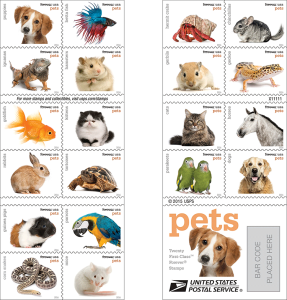 No postal stationery for 2016 has been announced (other than the Priority Mail envelope which, actually, was never announced but just issued). According to
No postal stationery for 2016 has been announced (other than the Priority Mail envelope which, actually, was never announced but just issued). According to 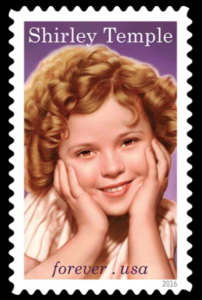 which is headquartered in New York City. However, this would be a stretch, because the stamp is part of the Legends of Hollywood series, all of which have been issued in Los Angeles.
which is headquartered in New York City. However, this would be a stretch, because the stamp is part of the Legends of Hollywood series, all of which have been issued in Los Angeles. Assateague Island National Seashore
Assateague Island National Seashore Carlsbad Caverns National Park
Carlsbad Caverns National Park Glacier Bay National Park and Preserve
Glacier Bay National Park and Preserve Gulf Islands National Seashore
Gulf Islands National Seashore Marsh-Billings-Rockefeller National Historic Park (NHP)
Marsh-Billings-Rockefeller National Historic Park (NHP) San Francisco Maritime Historical National Park
San Francisco Maritime Historical National Park The DCP measures 2.4″ x 1.5″
The DCP measures 2.4″ x 1.5″  The pictorial first-day postmark measures 2.4″ x 1.5″.
The pictorial first-day postmark measures 2.4″ x 1.5″.  The dedication postmark measures 3.0″ x 1.5″
The dedication postmark measures 3.0″ x 1.5″ On June 2, 2016, in New York, NY, the U.S. Postal Service® will issue the National Parks stamps (Forever® priced at 47 cents) in 16 designs, in a pressure-sensitive adhesive (PSA) pane of 16 stamps (Item 560600). The National Parks pane of 16 stamps may not be split, and the stamps may not be sold individually.
On June 2, 2016, in New York, NY, the U.S. Postal Service® will issue the National Parks stamps (Forever® priced at 47 cents) in 16 designs, in a pressure-sensitive adhesive (PSA) pane of 16 stamps (Item 560600). The National Parks pane of 16 stamps may not be split, and the stamps may not be sold individually.














 WASHINGTON — Today, the U.S. Postal Service previewed the second in its series of 16 Forever stamps commemorating the centennial of the National Park Service. The 16 stamps, intended to represent the diversity of areas in our national park system, are being previewed over the next three weeks.
WASHINGTON — Today, the U.S. Postal Service previewed the second in its series of 16 Forever stamps commemorating the centennial of the National Park Service. The 16 stamps, intended to represent the diversity of areas in our national park system, are being previewed over the next three weeks.
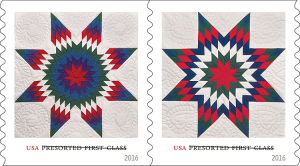 The first day of issue is July 6th.
The first day of issue is July 6th.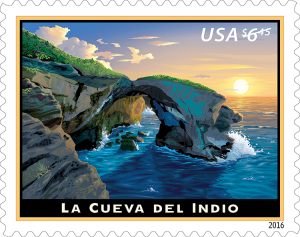 On January 17, 2016, in Washington, DC, the U.S. Postal Service® issued the $6.45 La Cueva del Indio Priority Mail® stamp, in one design, in a pressure–sensitive adhesive (PSA) pane of 10 stamps (Item 119100).
On January 17, 2016, in Washington, DC, the U.S. Postal Service® issued the $6.45 La Cueva del Indio Priority Mail® stamp, in one design, in a pressure–sensitive adhesive (PSA) pane of 10 stamps (Item 119100).

